




















CENTENNIALS
 Top
Top






















 Top
Top
GREETINGS with all of the pomp and circumstance of our illustrious alma mater’s centennial!
As we celebrate our history and legacy, this issue of TechTimes is dedi cated to what will be our own Tech story in the next hundred years. It’s hard to imagine that 100 years ago anyone could accurately predict the impact that Brooklyn Tech would have, or its place as the preeminent public STEM high school in these United States. However, high expectations of grandeur aren’t far-fetched given the scientific advancements, technological revolutions, engineering in novations and importance of mathematical calculations. STEM education will continue to create pathways and lead the world as we have witnessed in the last 100 years.
While it seems appropriate to merely laud our past accomplishments, this issue encourages us to also celebrate our future and pay homage to the imminent success of our next generation of leaders. Reflecting on the parable of how one drives, we are admonished to keep our focus on the road ahead. Yes, we use our rear-view mirrors to glance backwards. Yet we understand the necessity to look forward to successfully move forward. It is the dynamic of moving forward that demands the ability to intertwine the past with the future, a forward-facing view.
As I glance back in my rear-view mirror, I understand how fortunate I am to have personally known several iconic board leaders we have recently lost: John Lyons ’66, Larry Cary ’70, Susan Mayham ’76 and Jack Feinstein ’60. Each one has left a distinct legacy that will continue farther into the future than I bet they imagined. So ingrained into the fabric of our Foundation, I can’t imagine celebrating our centennial without them; however their memories will simply add to all that we celebrate.
As Brooklyn Tech crosses the threshold of 100, let us wish for Tech all that we haven’t even imagined – as well as all that we have dreamed of. May our beloved alma mater have even more success and relevancy in our next 100 years than our first. It is often said that the best way to predict the future is to create the future, so here’s to the next generation of Technites creating our Next 100 Years!

In This Issue: It’s Brooklyn Tech’s Centennial. Think about what that means for the future. Then, meet members of the Centennial Class of 2022 and rising stars in our alumni family.
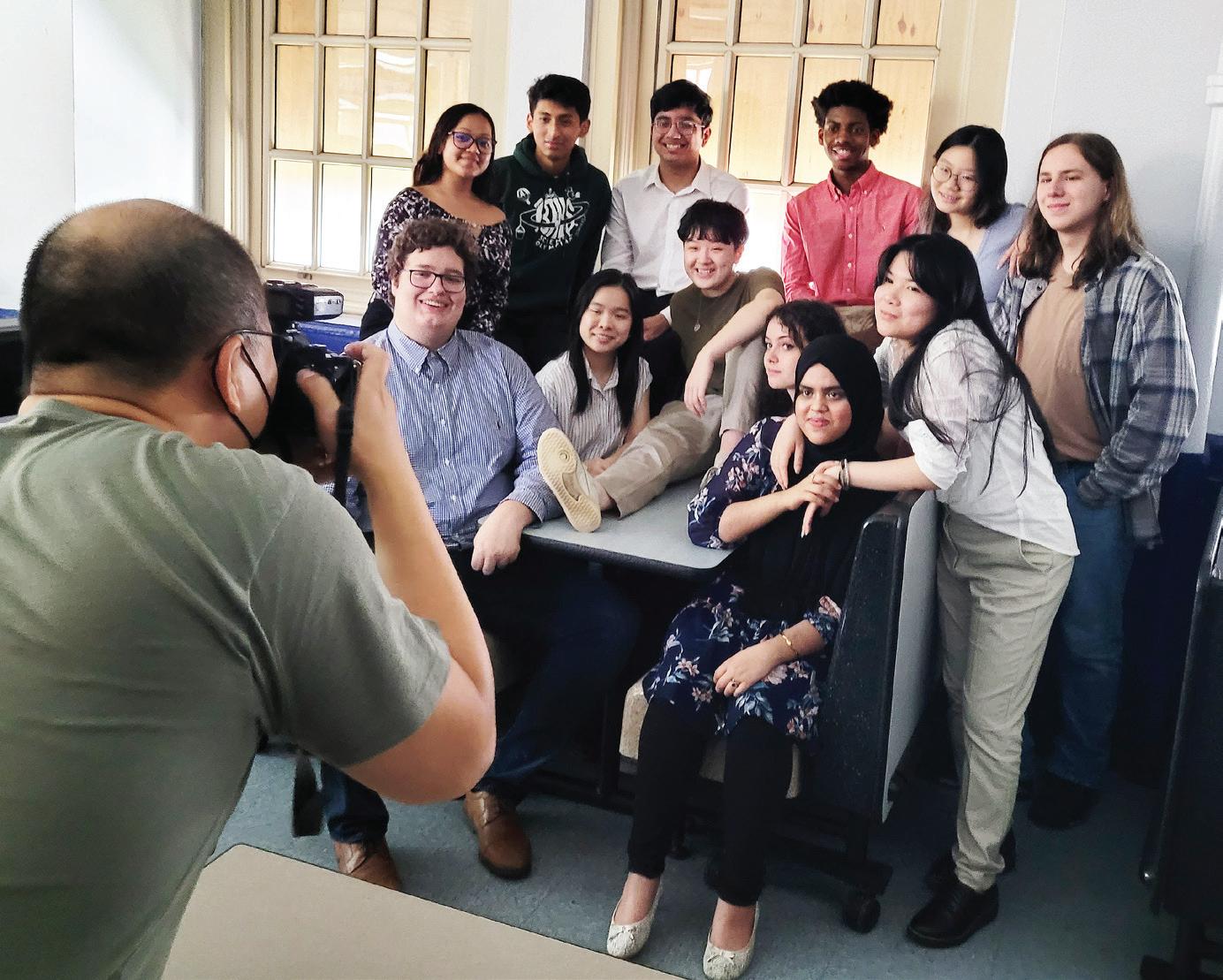
Editor In Chief and Chief Writer Ned Steele ’68
Art Director
Nicholas E. Torello
Chelsea Erin Vaughan
Intern Lucy Vuong ’22
Liaison Saira Masud ’23
©2022 Brooklyn Tech Alumni Foundation, Inc. Published annually. Articles may be reprinted with permission.
Alums: Send your letter to editor, or personal or professional update for publication in Class Notes, to: techtimes@bthsalum.org
“Photos by An Rong Xu”: The Backstory PROFILING WORLD-CLASS PHOTOGRAPHER An Rong Xu ’07 for our millennial alums feature (page 29) looked like a good idea. It quickly led to a better one.
Would An Rong be this issue’s guest photographer for the spread on Tech’s Centennial Class students?
Yes, to our eternal gratitude, he would.
Even better, we could deputize a “crew” of student photographers to assist him and to soak up insights about their craft from a master of it.
An Rong proposed staging the shoot in an iconic Tech setting. Magically, there is a day in June when the building is open but students stay home. An entire seventh floor cafeteria lay empty and waiting, a blank canvas.
We are indebted to An Rong for the riveting photography that day yielded (pages 12-21), and especially for the inspiration and mentorship he gave those young people. ■
I AM HUMBLED and inspired by the privilege of leading this amazing insti tution at this historic moment. As Brooklyn Tech celebrates its Centennial, I find myself looking forward toward the next hundred years. From the earliest days, a Tech education was regarded throughout New York City, and throughout industry, as a superb one. Much has changed since, but the core remains: we continue to lead, providing an innovative and cutting-edge educational experience for all of our students.
Brooklyn Tech has earned world renown not merely for our legacy and tradition, but for the work we do currently. As an example, I was recently invited to speak about the Brooklyn Tech educational model at two panels in an international conference in London. The vast number of attendees were fascinated by what we do daily and how we do it.
Our school continues to receive national recognition, as evidenced by some of the highest historical ratings in U.S. News and World Report rankings for the past four years – placing in the top 50 schools in the nation each of those years.
We adapt our model and student educational experience every year to match trends in high er education and industry. We prepare students for jobs that haven’t even been created yet, by empowering them to attain the skillset and interpersonal skills needed to succeed. With the exceptional caliber of our students, our dynamic curriculum and our cutting-edge educational facilities, we have assembled a faculty unrivaled in New York City. Students are attaining mas tery of Advanced Placement courses and gaining entry to the college of their choice at levels never previously experienced.
We all know what a special place our school is, and the world knows it as well. I look forward to Brooklyn Tech continuing to lead for the next 100 years, with its graduates achieving limitless impact on the world. Thank you, our alumni family, for all you do to enhance our educational experience, and for inspiring our young people to realize their full potential.
David Newman Principal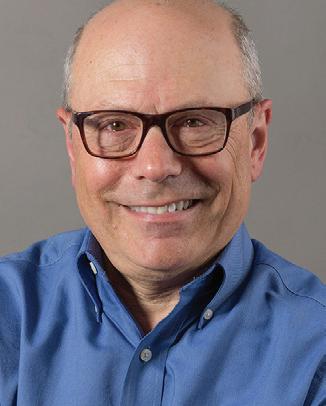








WE ASKED FIVE SMART PEOPLE – four alums and a senior school ad ministrator – to contemplate the future of STEM education for this special issue, and to envision Tech’s role in it.
We aim each time to be a breezy, easy, and hopefully informative read. We know you don’t have time for laborious reading about your high school. Still, I invite you to join in the somewhat deeper dive that kicks off this edition.
Full transparency: It’s an invite with an ulterior motive. We’re hoping that after considering the importance to our society of STEM education, and seeing what Tech is doing and planning, you’ll be encouraged to support your alma mater.
After our “deep think” opening, our pages move on to celebrate some of our accomplished alums and amazing students.
What’s it like to be 17 years old and wake up one day to learn you are about to meet a former President of the United States and introduce him to a crowd of thousands? That’s what happened to senior class president Michelle Li ’22 at last June’s graduation ceremony in Arthur Ashe Sta dium, keynoted by Bill Clinton. Michelle is profiled in this issue, but you’ll have to click into our bonus online video/print content package to see and hear her recount the experience. There’s lots more in the package – please have a look.
Finally, a shout-out to celebrated photographer An Rong Xu ’07, who made room in his busy schedule to conceive and create this year’s student portrait photography section. Working with him, and his evocative art, was my highlight of this TechTimes production cycle.





A rich package of bonus videos and articles awaits you online. Click this icon on many features and view bonus content in our online edition: bthsalumni.org/ techtimesfall22


Designer Signe Kaljurand’s Centennial logo, widely seen throughout the year’s festivities, goes golden. The “100” emblem, Kaljurand says, “simplifies and modernizes the original Brooklyn Tech seal and introduces a roadway linking the past to the future.”

MORE THAN 500 YEARS AGO, LEONARDO da Vinci developed conceptual designs for the parachute, airplane and helicopter, all of which took centuries to become reality. In 1962, William Hanna and Joseph Barbera, creators of “The Jetsons” cartoon, imagined audio/vi sual communications, smart screens, digital watches and shoes, robotic help, 3-D printing and drones. All came to pass in decades.
Today, the fastest supercomputer performs at a speed of 415 petaflops (quadrillions of operations per second).
By Anthony BartolomeoJust 10 years ago, the most advanced supercomputer performed at 2.5 peta flops.
This is the power of exponential growth: call it “tech-celeration.” Under standing it is essential to projecting the needs and challenges that society will call on STEM professionals to solve.
That inevitably places the respon sibility on our education system, par ticularly STEM education. Delivering a strong curriculum in math and sci ence—the hallmark of STEM educa tion’s first century—is now just the be ginning. Imparting an appreciation for the pace at which technology is accel erating, and for how life-long learning will be critical for career success and the ability to significantly contribute to society’s well-being, is STEM educa tion’s new job.
Life in the next 100 years is likely to be influenced by a few major trends in the process of evolving today: climate change, alternative energy, artificial in telligence, autonomous transportation, and smart cities.
To prepare students, education needs to introduce them to systems thinking—so important because the criti cal elements and aspects of healthy, sus tainable societies are quite interdepen dent. Think of the systems which we rely on every day: energy, water resources, waste management, transportation and communications, all technology-driven infrastructure assets.
Now incorporate the systems asso ciated with public safety, healthcare, law enforcement, banking and com merce, and one gains an appreciation for the interconnectivity of this “sys tem of systems.” Optimal solutions to societal needs must incorporate sys tems-thinking approaches. STEM edu cation of the 21st century: that’s your challenge. ■
Anthony Bartolomeo is the retired president of engineering firm Pennoni and a driving force in the American Society of Civil Engineering’s Future World Vision initiative.

THE PLACE TO START THINKING ABOUT THE FUTURE OF STEM EDUCATION, at Brooklyn Tech and elsewhere, is the wellspring of tomorrow’s science and technology talent—the elementary and middle schools.
One need not be an expert to conclude that the present situation is not good. Mostly, science, technology, and engineering—the “STE” of “STEM”— are all but ignored in elementary school, though some aspects of science are taught. Why? I think that a – if not the – main reason is that the vast majority of teachers in these schools have little background in these subjects, perhaps because there has never been much emphasis on teaching them at this stage of education. Concomitantly, teachers of these grades are usually not well-
If teachers could be motivated and the needed fund ing made available, a massive national effort could be undertaken to substantially increase the competence of these teachers in these subjects and in how to teach them most effectively. Whether such is achievable, given the realities of our present culture and economic situa tion, is certainly questionable. One prerequisite for suc cess might well be a change in the status of the teachers, exemplified by their pay.
By Irwin Shapiro ’47At the high school level, there is an additional prob lem. Although sciences are part of the standard curric ulum, the textbooks are mostly behemoths that contain tons of material, in total far too much for most students— or teachers—to absorb. Why is this? I do not know. But I suspect it is in major part the profit motive of textbook manufacturers.
Now that I have painted this somewhat gloomy picture of pre-college STEM education, what more attractive possibility would I like to see ahead? Given my profession as a scientist, I will concentrate far more on the “SM” than on the “TE.”
Because of space limits, let me consider only trends now visible. As tech nology continues to develop, more and more data will be stored in less and less physical space. An obvious implication: less and less need for students to remember things, certainly not de tails. It might seem that all a person would need to learn is how to identi fy and then access information from storage devices or, equivalently, “the cloud.” However, I believe that people would have to learn much more. To identify what to seek, they will need to understand at least the fundamen tals of the subject they want to mas ter and how to use the material they will be able to retrieve from the cloud. One can hope that the problem of be hemoth textbooks might be naturally solved.
Another major trend is science’s increasing observations of how na ture works and the availability of these observations via “big data.” Here the prospects are very bright. Data are being collected on nature’s behavior in all sorts of ways from all


WITH ARTIFICIAL INTELLIGENCE, machine learning, and big data rapid ly evolving and becoming integral to nearly all aspects of daily living, one of the most pressing challenges for high school students is to truly understand what it means to be human in this age of algorithms and complex societal chal lenges.


 By Dorothy Teneketges Bennett ’82
By Dorothy Teneketges Bennett ’82
What that requires, I believe, is hav ing the ability to critically question, ap ply, and reimagine how these new sys tems can aid in decision-making and problem- solving to benefit the lives of everyone.
In some ways, these times call for what has been the ethos of Brooklyn Technical High School since its incep tion: an engineering mindset. The en gineering mindset is not merely about designing and mastering the latest cut ting-edge technologies. It’s about hav ing the attitudes, knowledge and skills to move beyond being consumers of the world to being creators and shapers of solutions that improve the lives of our communities, deepen humanity and preserve the natural world.
What does this mean for the future of STEM education, especially at a pre mier technical high school like Brooklyn Tech?
In my 30 years of researching and developing STEM education experienc es, I’ve observed this about the most impactful programs in times of great technological change: they often focus on cultivating students’ habits of mind in the context of solving problems that are personally meaningful, interdisci plinary and project-based.
The American Association of Engi neering Education has a roadmap to get us there. It has identified the habits of mind that prepare young people for jobs of the future and foster active cit izenship. They apply broadly to what a 21st century well-rounded education for the future could be: supporting students to always think about how things can be
Collaboration: work in teams and actively seek out di verse perspectives;
ing from failure and trying again;
new relationships in the world and imagining new ways of doing things;
empathy for others and weighing ethical

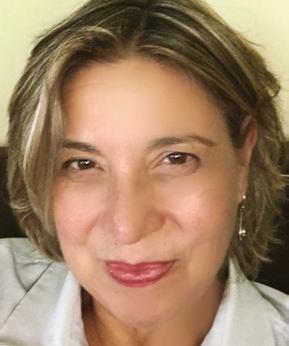
CELEBRATING BROOKLYN TECH’S CENtennial provides the opportunity to not only reflect upon Brooklyn Tech’s leadership role in STEM education over the past 100 years, but to look ahead and see how Tech will continue to be a force and a resource in shaping the future of STEM education.
The visionary Dr. Albert Colston, Tech’s founding principal, had spent con siderable time researching the nation’s top specialized technical high schools. This enabled him to articulate the need for a modern technical high school, and to outline a curriculum model that incor porated theory as well as application. He emphasized the difference between a vo cational and technical education, and he advanced a vision of developing young men equipped to be leaders in the emerg ing “machine age.”
Colston knew that a successful sec ondary education was, as John Dewey noted, “not preparation for life, but rath er life itself.” Technites were given exten sive leadership opportunities in service squads, honor societies, clubs, depart mental publications, the school newspa per, and academic and sports teams.
These activities were, and remain to day, integral components, along with in ternships and work-based experiences, of the transformational Brooklyn Tech education. When coupled with a powerful curriculum that focuses on problem solv ing and critical thinking, they are the core of a high-quality STEM education.
As Brooklyn Tech continues shaping STEM education, it has the Alumni Foun dation as its strategic partner. This is es sential to help generate resources to sup port Tech’s enhanced STEM program.
Tech’s alma mater song challenges graduates to “bring honor and praise” to Tech’s name. This challenge drove the for mation of the Alumni Foundation in 1983. Its dual purpose is to bring alumni togeth er and to be a resource helping Tech sus tain its high-quality education. In addition to raising millions of dollars toward that goal, the Foundation, working with the
school, developed a modernization plan that continues to enable Tech to fully pre pare students for the digital age.
With its highly diverse population of 6,000 students annually, Brooklyn Tech is by far the largest specialized high school in the country. This amazing size makes Tech significant in addressing the need for well-prepared graduates to ultimately enter STEM-related fields.
Tech’s capacity and unique facility enable its 18 academic majors (including such 21st century fields as bi ological science, environmental science, robotics and software engineering) to encompass the many dimensions of modern STEM education and be an in cubator of innovative curricula.
Tech’s majors provide stu dent explorations in areas of interest that usually do not take place until college. Combining academic preparation with a career orientation enables stu dents to see the interconnect edness between the classroom and the “real world” ahead.
opment so the labs fully complement the major curriculum. They develop internship experiences relevant to the majors, pre paring students and teachers in real time for a changing world.
Tech has chapters or clubs of profes sional organizations including the Amer ican Society of Civil Engineers (ASCE), American Institute of Architects (AIA) and National Society of Black Engineers (NSBE). Such chapters do not usually ex ist in high schools. More of these connec tions will be created, benefiting Tech students and becoming models for other schools.
The civil engineering major’s materi als testing lab, the law and society ma jor’s moot courtroom, and the aerospace major’s flight simulator lab are but three examples of special facilities that actual ize learning. All Tech majors encompass these experiences and, in many ways, de fine a Tech education.
For Brooklyn Tech to remain a leader, the Alumni Foundation and the school form partnerships that affiliate the majors with colleges, universities, corporations, stakeholders and professional organiza tions. For example, the American Society of Mechanical Engineers (ASME), New York Institute of Technology, Stevens In stitute of Technology, NYU Tandon, Nano tronics, Con Edison, and National Grid are linked to the mechatronics major.
These partners work with Tech faculty to review curriculum and to explore and identify new avenues for laboratory devel
An amazing Tech educa tion should be accessible to all young people. It is important that Brooklyn Tech be a leader in creating pathways to address the under representation of Af rican American, Latinx, and women in STEM fields.
We started in 2013 with the National Grid/Brooklyn Tech Alumni Foundation/Brooklyn Tech Middle School STEM Pipeline pro gram as a pioneering effort to attract students from low-income communities to STEM education generally, and specif ically to Tech. Today our partnership with ASCE has developed the Future World Vision STEM Pathways Consortium. This ground-breaking initiative pairs Brooklyn Tech with seven Brooklyn middle schools and strategically connects school leaders, specialized faculty, and students.
Our journey in the years ahead will be exciting as Brooklyn Tech remains a STEM leader and becomes an even greater re source for other schools. This will build essential bridges that create a continuum for middle school, high school, and col lege STEM education. Our programs will be replicated in other schools. Tech will be a center for professional development for teachers throughout New York City.
All this will be made possible with the collaborative participation of our alumni, partners, and the Department of Educa tion—and Brooklyn Tech will continue to shape the future of STEM education for the next 100 years. ■
Alumni Foundation co-founder and Chief Educational Officer Mathew M. Mandery ’61 is the only Tech alum to serve as Brooklyn Tech Principal (1983 -87).

ALBERT COLSTON’S VISION FOR TODAY — AND TOMORROW
There are significant efforts towards inclusivity, equity, and access. External supplemental education organizations like Girls Who Code, which has a chapter in-house, and AllStarCode, a program for young men of color, address some of the inequities in the demographic make up in computer science. As a result, we are recipients for three years in a row of the College Board AP Computer Sci ence Female Diversity Award for closing the field’s gender gap.
Our major’s classes provide founda tions in Java, Python, HTML 5, Cascad ing Style Sheets (CSS), JavaScript, PHP server-side programming, transistor log ic, circuit building with microcontrollers, data security, security architecture and SQL. To accommodate such a breadth, the major has four semester-long in tensive courses: Web Development, IT Infrastructure, Data Warehousing and Analytics, and Cyber Security.
The vision of Schools Chancellor David C. Banks is “that each and ev ery one of our students graduates with a plan and a pathway to a rewarding career, long-term economic security, and equipped to be a positive force for change in our communities and our city.” This aligns with Tech founder Dr. Albert Colston’s 1918 goal of “preparing young men for the workforce.”
Tech’s solution remains a robust course offering within the majors sys tem, continually modified based on in dustry trends and data.
Some givens stand at the forefront. Fact: most industries will require em ployees with some knowledge of com puter science. Along with obvious high-
It should come as no surprise to alumni that their alma mater is forging new pathways to keep our school’s status as the nation’s leader in science, technology, engineering and math (STEM) edu cation and student achievement. Our Electrical and Software Engineering (ESE) programs are taking action to meet the demand for future in novators and productive contributors to Ameri can society. A ROBUST COURSE OFFERING, TAUGHT BY THE BEST EDUCATORS PAYING IT FORWARD
tech fields like artificial intelligence and enterprise software, Forbes’ Technol ogy Council listed these industries in need of programmers: government and social services, agriculture, education and even “traditional industries.” The Bureau of Labor Statistics projects a 12% growth in the IT industry by 2028. Job titles will include developers, data base developers, dev ops engineers, full stack developers and security.

Mindful that high school students who take Advanced Placement (AP) computer science (Java) are eight times more likely to major in computer science in college, we are growing through ex pansion of computer labs and increased hiring; faculty has doubled in just five years. Software engineering is the most sought-after major in the school; de mand for seats exceeds supply.
The lodestar of our program’s tra jectory: a network of the best educators paying it forward to future generations through teaching. Many electrical and software engineering department fac ulty hold degrees in electrical engineer ing, computer engineering or computer science. Our teachers bring work expe rience from across the industry, includ ing Goldman Sachs, Harris Corporation, Audible Inc. (an Amazon company) and Standard & Poor’s. Specialized high school backgrounds loom large on our team, with six graduates from Tech, Stuyvesant, Bronx Science, and Staten Island Tech.
We create opportunities for stu dents by mandating that all sophomore students take AP Computer Science Principles (AP CSP), the equivalent of a college first-semester introductory com puting course.
Augmenting this robust sequence are internship experiences with com panies like Amazon, Con Edison, and Deutsche Bank. We guarantee that our students graduate having had opportu nities to encounter engaging and rele vant problems.
Tech is enormous, as you know from having walked these halls as students. Our programs must adapt to scale with increased enrollment so we can con tinue to meet future technology-driv en trends. As large as Tech is, we can nimbly adjust to whatever the future brings, because at Tech we thrive the most when presented with the toughest problems. It is a running constant that we are Technites, and we will always rise to the challenge of the moment. ■
Rosabeth Eddy, an assistant principal, supervised Tech’s computer science and engineering program for several years.

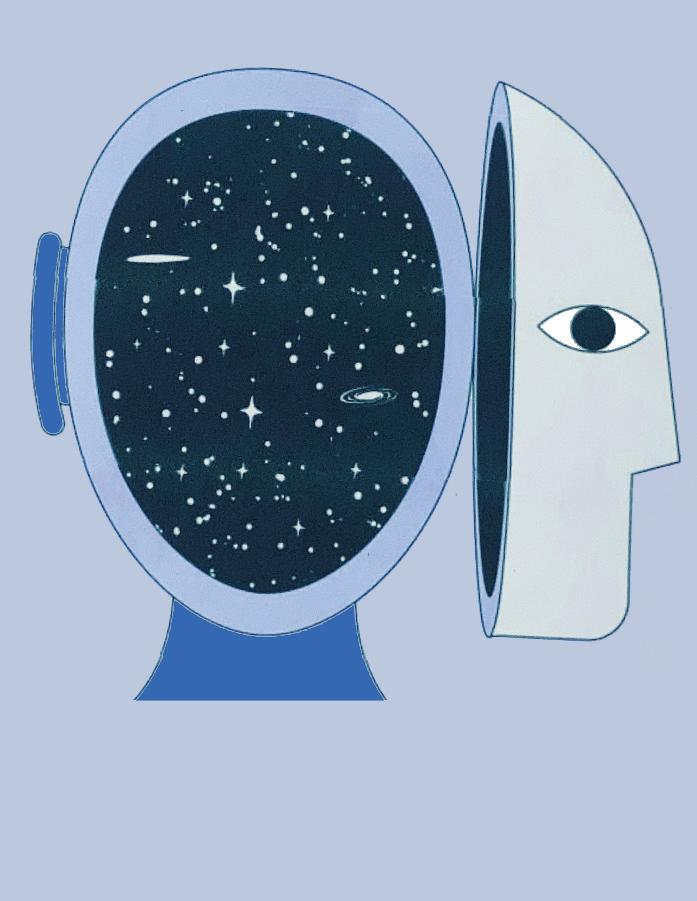
ROOM 1N3, A FORMER industrial-era shop now aglow in the bright light of 30 computers, students lean into their
and see their future.
We’re in Big Data, a course for
engineering major seniors invented at – and taught only at –Brooklyn Tech.
College-level and then some, it introduces the same knowledge and skills that adults in real-world technology jobs are applying at that exact moment.
These students have already taken Cybersecurity (another industryfocused, Tech-only course), mastered two college-level Advanced Placement computer science courses, and zipped through Java, Web Development, and Fundamentals of IT Infrastructure.
The majors system has long defined the Brooklyn Tech experience and set the school apart from all others. From the early years through present day, the range of majors and the curriculum have constantly evolved to meet each era’s educational needs — always with an eye on the future.
Here’s the lineup of Brooklyn Tech’s 18 current majors. Is yours still on the list, or has it morphed into something adapted and reimagined for today’s — and tomorrow’s — world?
ADVANCED HEALTH
AEROSPACE
APPLIED MATHEMATICS
ARCHITECTURE
BIOLOGICAL SCIENCES
CHEMISTRY
ENGINEERING
ELECTRICAL ENGINEERING
SCIENCE
FINANCE
INDUSTRIAL DESIGN
& SOCIETY
MECHATRONICS & ROBOTICS
MEDIA
PHARMACY
PHYSICS
SCIENCE RESEARCH
SOFTWARE ENGINEERING
local CVS or Walgreens once they turn 18.
ON THE THIRD FLOOR, other Technites are effectively already in college. Majoring in pharmacy, they follow a course sequence that guarantees admission to nearby Long Island University’s Doctor of Phar macy (PharmD) program and grants full credit for its freshman year classes. No applications, fees, essays or interviews needed.
Meanwhile, in Modern Physics (quantum mechanics plus “a rigorous understanding of the fundamental interaction of particles,” ac cording to the syllabus), other students are doing work that will get them admission (ap plication waived) and first-year course credit at SUNY Old Westbury.
At Brooklyn Tech, the future literally is now.
“WE WANT THE MAJOR TO LEAD TO SOMETHING bigger and better,” says Thom as Evangelist, assistant principal for chemis try and physics and the driving force behind the LIU PharmD major and the Old Westbury physics program. “They’re here, they’re in the yearbook, and that’s it? What is the extension of what we do here?”
Students, and their parents, get it: Three years ago, the PharmD program graduated 28 seniors. This year it will produce 68. They will graduate having learned to compound and to fill mock prescriptions (using M&Ms). With fi
For alumni of the 1960s and 1970s who may have loved patternmaking, foundry, and other hands-on industrial era experiences but ques tioned the relevance to contemporary careers, today’s Tech might seem unrecognizable.
The school and the Alumni Foundation share another future focus: incubating a more racially and gender-diversi fied future STEM workforce. Amid the software engineering major’s overall growth, the number of Black and female students has doubled since 2020.
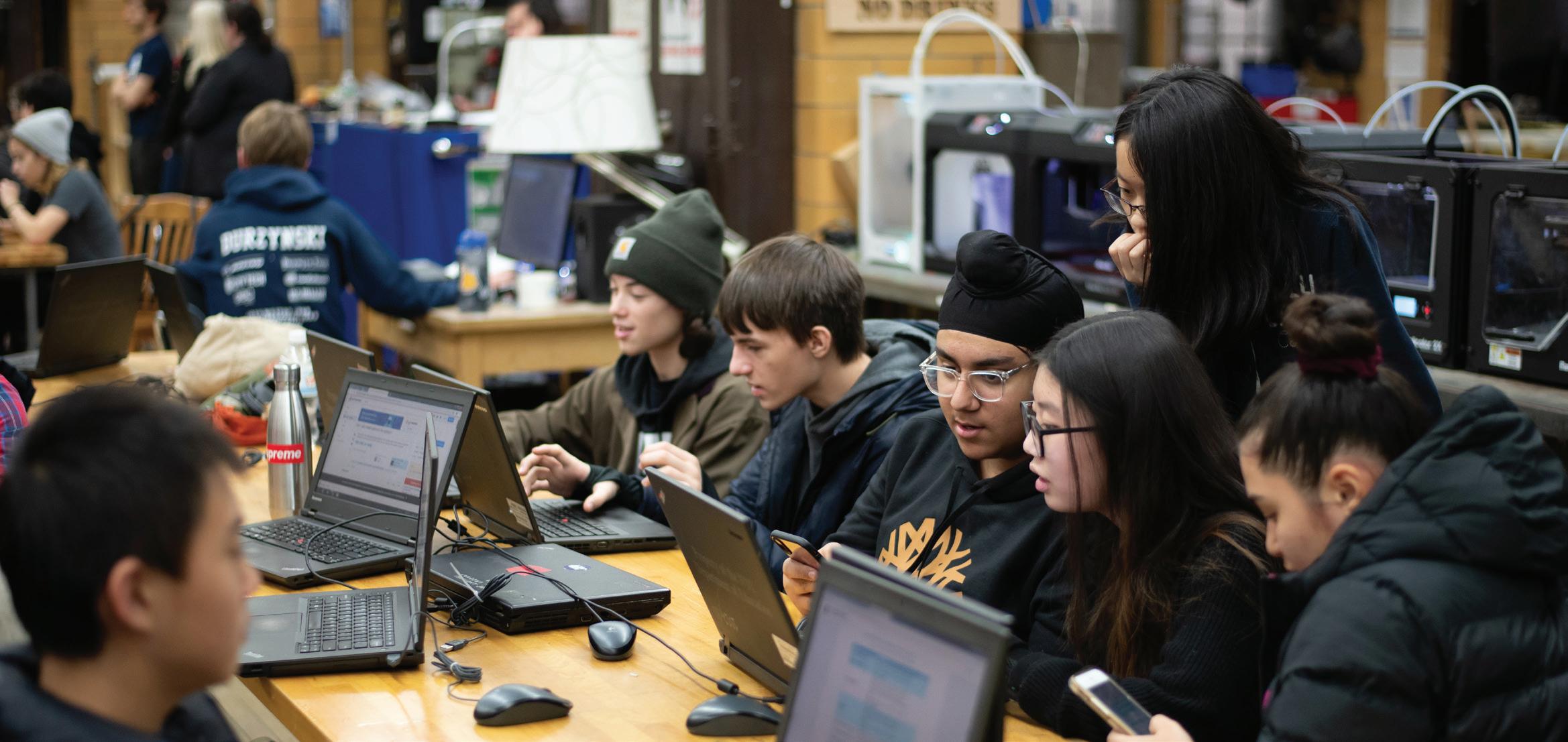
BACK IN ROOM 1N3, THE BIG DATA students are working independently at their computers, manipulat ing thousands of data points in an eyeblink with their coding skills. It’s an exercise that will have them replicating the way a restaurant chain analyzes such huge amounts of data as the location of ev ery AirBnB in New York City, to determine where to open new outlets. As the end bell rings teacher Mark Rodríguez promises, “Tomorrow we will add some complexity to the problem.”
The Alumni Foundation and Tech are partnering to develop STEM pathways initiatives to attract middle schoolers to the STEM professions – and to Tech. The idea is that as a rich storehouse of STEM pedagogy, Tech can be a resource for feeder middle schools in underrepresented communities, introducing pre-high schoolers to technology’s opportuni ties. [See page 6.]
“STEM education has to find ways for cross-age learn ing,” says Alumni Foundation Chief Educational Officer Dr. Mathew Mandery.
Rodríguez, who developed the course, likens it to a first-year medical school resi
Every Tech sophomore takes a college-level computer science class.
hard and multifaceted. There’s more than one solution. These students won’t be intimidated by anything they see as college freshmen.”
They will, in fact, emerge on track to aim for future careers in cloud computing, system administration, DevOps (a combination of soft ware development and operations), data sci ence and similar advanced fields.
Before taking this class, student Arina Var danyan already knew a thing or two about com puters. She first took coding in eighth grade. But Rodríguez told the class, she recalled, that “Computer science is 90% thinking and 10% coding.” The course grounded her in system structures, data management, machine learn ing, and soft skills like working and communi cating in teams.
“These are foundational skills,” she said. “You need to understand how things work.”
ARINA AND HER CLASSMATES LEARN AS software engineering majors will be as up-todate as possible, considering they are four years from a college diploma. The curriculum
is updated regularly, as much as 30% a year, to reflect industry trends. Faculty and administra tors contact young alums to ask, “What did we miss?” says Rodríguez’s supervisor, assistant principal Rosabeth Eddy.
Tech’s schoolwide focus on the future is driven by a new generation of administrators and faculty. Half of the software engineering faculty, including Rodríguez, came from tech nology-related first careers, much as the teach ers of yore often came out of industry.
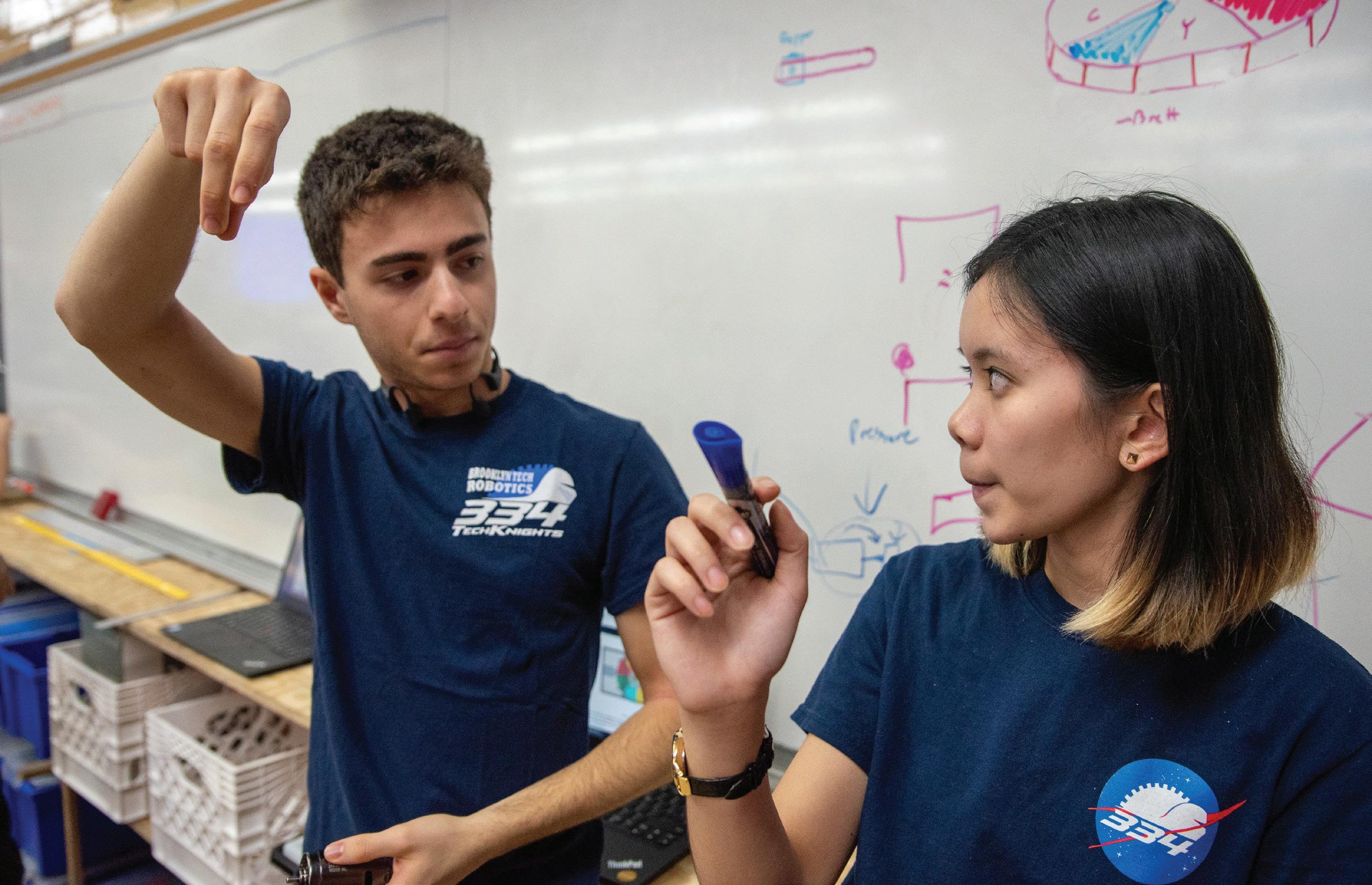
Today’s Technites, as their predecessors, welcome this presence of the practical in the classroom. These teachers are especially ef fective at attracting sophomores to enter the computer majors.
Thes students “are not looking to be the next Bill Gates or Mark Zuckerberg,” says Eddy. “Our software engineering majors want mar ketable skills. They want to have a good job, be able to live in this city, and give back to their parents.” Many, she says, eventually work with tech field leaders like Google and Facebook.
Not surprisingly, enrollment in Tech’s com puter majors has quadrupled since 2015.
Brooklyn Tech’s majors may cover just two years on the calendar – but in software engi neering, pharmacy and the 16 others, what goes on in class is reaching all the way into the future. ■
at Brooklyn Tech.
The state has approved funding for creation of a Virtual Reality Design Lab, believed to be the first of its kind in a New York City public school, to be stocked with cutting-edge hardware and software.
Virtual Reality, or VR, is moving beyond the entertainment and gaming functions where it began, with many predicting its impact on business and daily life will be huge. Major players like Meta (Facebook), Apple and Sony are diving in. Military, aerospace, and medical uses of the technology are mushrooming.
At Tech, architecture and civil engineering students will be early users of the facility. Through the Alumni Foundation’s STEM Pathways Consortium program, seven central Brooklyn middle schools will have access to the lab.
Funding was provided by Assembly Members Latrice Walker (BTHS ’97), Phara Souffrant Forrest, and Peter Abbate. Details of the new program, including its location and completion date, will be determined later.
TO 2022 GRADUATE Stephan McGlashan, “We are no different than the hundred classes that came before us and the hundred that will come after,”
We know exactly what you mean, Stephan: that shared legacy and expectation of excellence. But also… there was something special about the Centennial Class. “It is a reminder that we are the next generation of greatness,” said senior class president Michelle Li.
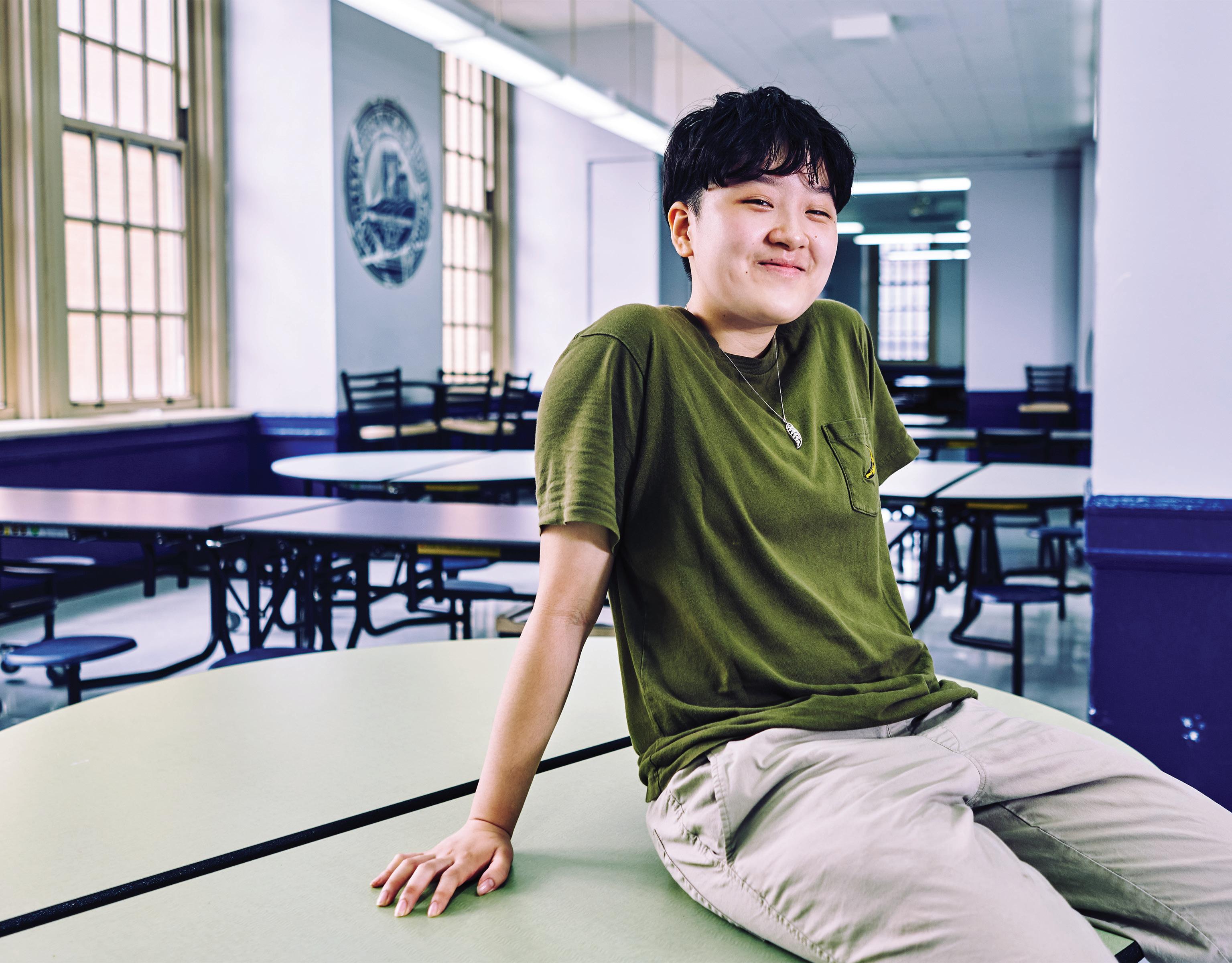
All 1,477 of them, in their own individual way, were special. Here, meet ten.
Photography by An Rong Xu ’07An Rong Xu’s photography has illuminated some of the world’s leading media outlets. (See page 29)
Challenge: “I grew up not having resources. I came to understand the gravity of living in poverty as an Asian American.”
Serving others: Volunteer translator and tutor for several community organizations.
President of Tech’s 1,000-member Outreach club; it provided 7,000 hours of student service during her term. Members raised money for autism, served in museums and nursing homes, and made thankyou cards for first responders: “Sometimes Tech is like a bubble; we don’t step back and
think about the whole world. Cleaning up a park reminds us of our humanity. You stop thinking about SATs and college applications.”
Claim to fame: Dora led the group that provides tours of Tech to middle school students. College plan: Marketing and sociology: “Those fields come together naturally. Sociology is studying people and their interactions with society. This is what I’ve been trying to figure out my entire life.”
For fun: Dora is a superstar at building playing card towers: “I developed the patience for it over the years.”
Achievement: His research paper on remote educational testing was one of 25 winners in a Harvard-affiliated nationwide high school competition.
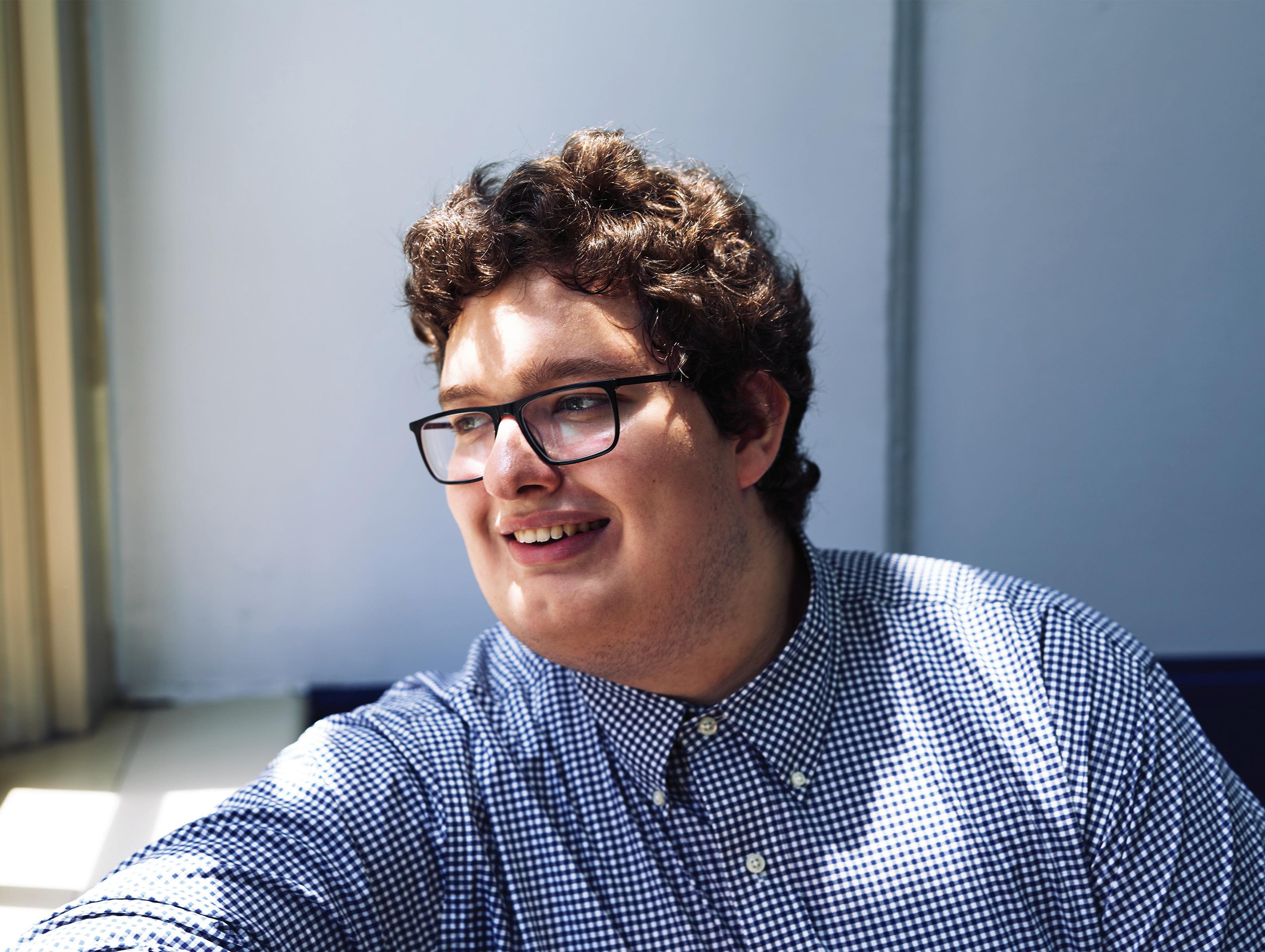
Claim to fame: Believed to be the tallest person in the school (6’8”).
Extracurricular: Model UN and debate team: “STEM study and debate complement each other. I enjoy debating over the right answers in my STEM classes.”
Tech gave me: “The life skills I need to succeed. A focus on preparing students for careers that will be, and not careers that have been.
Influential book: The Fortress of Solitude by Jonathan Lethem
Serving others: Admir volunteers at his community mosque to provide food for the needy.
The Centennial: “Once I realized how over 60% of my fellow students are below the poverty line yet still surmount any obstacle thrown at them, I realized what an amazing institution Tech is and how many people it has helped climb the socioeconomic ladder for 100 years.”
Accomplishment: During the pandemic shutdown, started with others a student mental health club. Virtual meetings start with a meditation, followed by discussions about anxiety, time management, post-traumatic stress, and other teenage concerns. Based on that experience, Daniel
was invited to lead similar discussions at a Brooklyn middle school.
Claim to fame: Friends called him “the therapist:” late at night when the homework was done, he was their go-to person for phone conversations about whatever was on their minds.
College and career plan: “I won’t just be a math
MAJOR: Applied Mathematics
COLLEGE: Columbia
BORN: Brooklyn
PARENTS BORN: Peru
major.” Drawn to chemistry and materials science, Daniel hopes to become a scientist. Inspired by an article he read on the use of gold nanoparticles to fight cancer, he aims to start a nanotechnology business one day.
Tech taught me: “You can do everything right yet still fail. Now that I’ve graduated, I
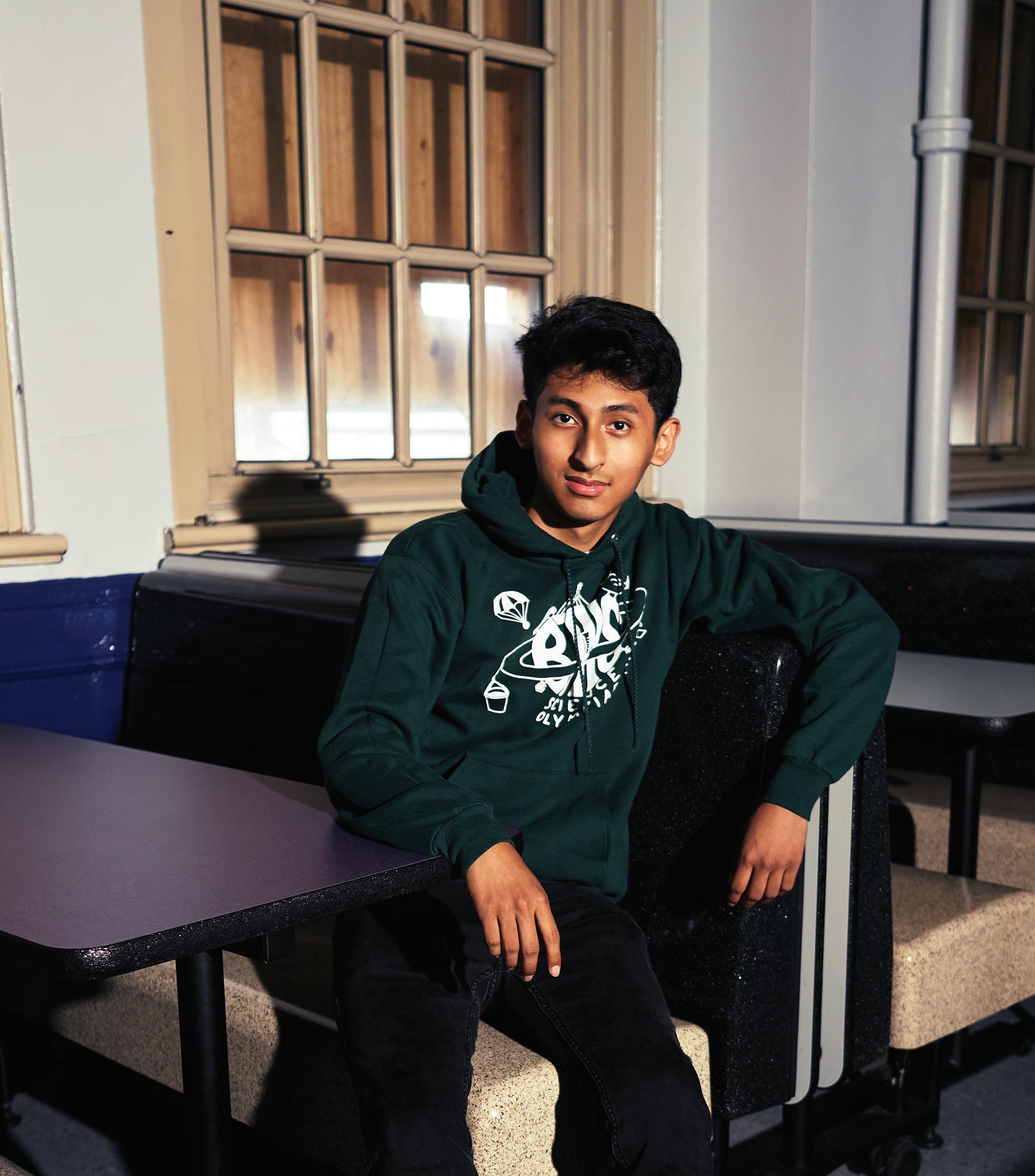
understand that not everything is going to go according to plan. But I’m mentally prepared for what comes next.”
Influential book: Frankenstein: “The idea was that ambition can’t be everything.”
The Centennial: “The prime factorization of 2022 is 2 x 3 x 337. Clearly, one example of a real-world application.” ■
Really good at: Chemistry: Aleksandra started reading science books in third grade, around when she started inventing her own experiments in elementary school: “Chemistry was my first love. More girls are going into it.”
Accomplishment: As a Weston Research Scholar, Aleksandra interned for three years on a team of Mount Sinai Hospital scientists investigating Covid. Being surrounded by graduate students and post-doctoral researchers was “super intimidating,” and she had to learn coding and read research papers on her own to keep up: “I could have said, ‘I’m only 15 and I don’t have a degree; I should do something else.’ But I stuck with it.”
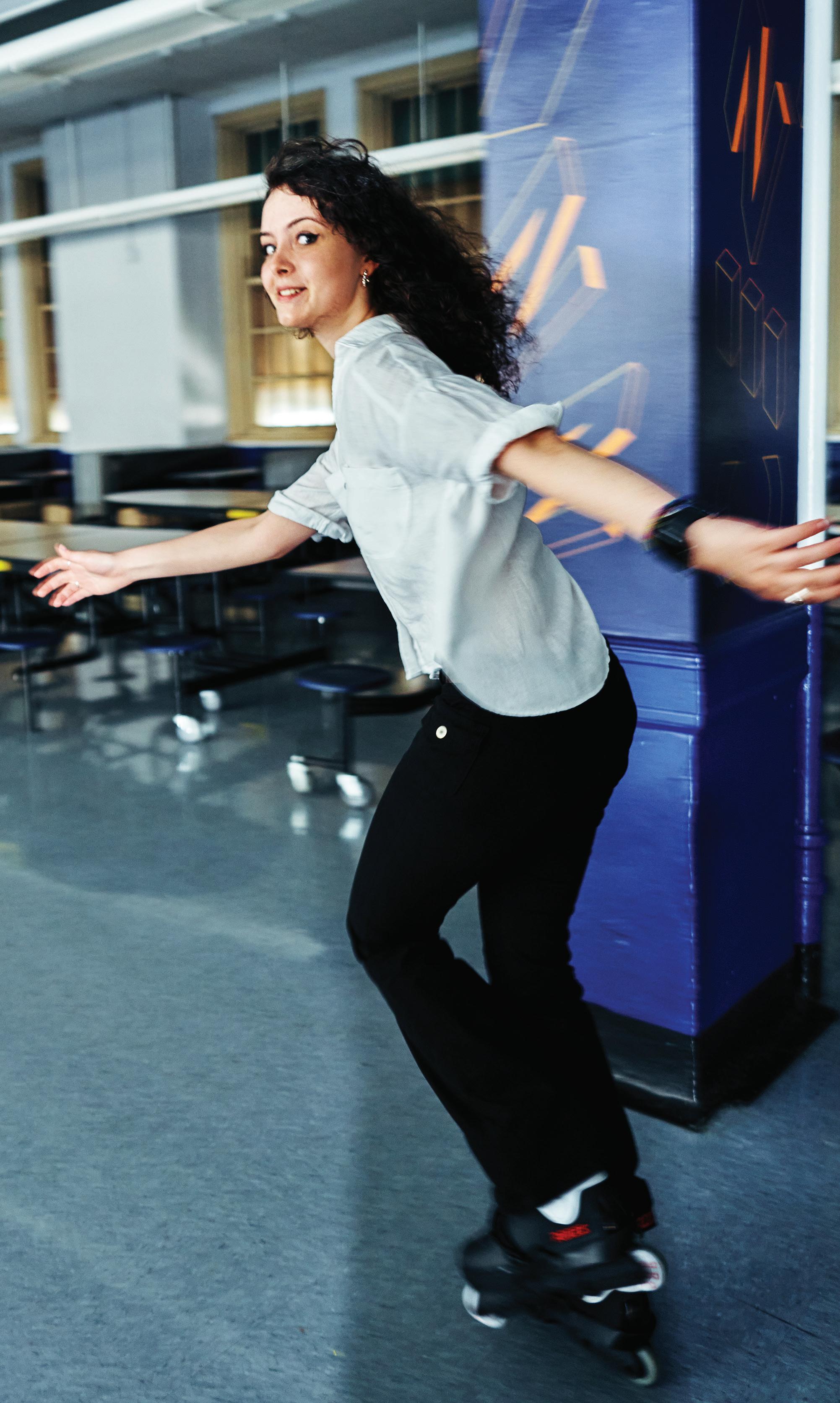
College and career plan: Chemical engineering “is set in stone for me,” but she’ll explore biotech. Then she’ll work in nuclear chemistry or pharmaceuticals: “If I do it right, I can help a lot of people.”
For fun: Rollerblading, since she was ten. At 14 she joined a group that blades into the night at Union Square, Central Park and beyond. She owns a half dozen pairs of rollerblades “and over 40 wheels in addition to an insane amount of screws and wrenches.”
The Centennial: “I imagine it as a stone. One side has been already engraved in memories, people, and Tech’s proudest in ventions that have culminated into things we see daily. So we’re now imprinting new inventions onto the other side of the stone.” ■
MAJOR:

Challenge: Failed his first geometry class and made the experience a motivating tool: he enrolled in the mathematics major. “It was an opportunity to make a new start in something I had been punching a brick wall at for years.”
Tech gave me: “My most valuable asset, motivation. Brooklyn Tech has ignited an insatiable flame within me to succeed.”
My special place: “The architecture of the auditorium, especially the mezzanine. I was in awe the first time I saw it. I thought I was in a Broadway production.”
Accomplishment: For an MIT competition, created an app that uses artificial intelligence and localization software to generate race track paths in the sky for drone racing.
College plan: “Prepare for a professional or academic setting in science. Computer science, AI, space travel. I feel more than prepared to tackle the challenge.”
For fun: Snowboarding in winter, summers sailing in Long Island Sound. Created a photographic history of life in the pandemic.
Extracurricular: Four years on the robotics team.
The Centennial: “We’re no different than the hundred classes that came before us and the hundred that will come after… we all developed the same mindset: be productive and contribute to society.” ■
Motivation: Before Thomas was born, his older brother suffered a debilitating stroke. Growing up, Thomas became a helper, eventually helping teach his brother to walk and play water volleyball: “I learned I could change someone’s entire world.” Thomas wants to change other people’s worlds by majoring in the emerging field of biomechatronics at MIT and going on to build mobility-enhancing devices for the handicapped: “If I could help my brother walk better in a few years, robotics holds so much potential to do more.”
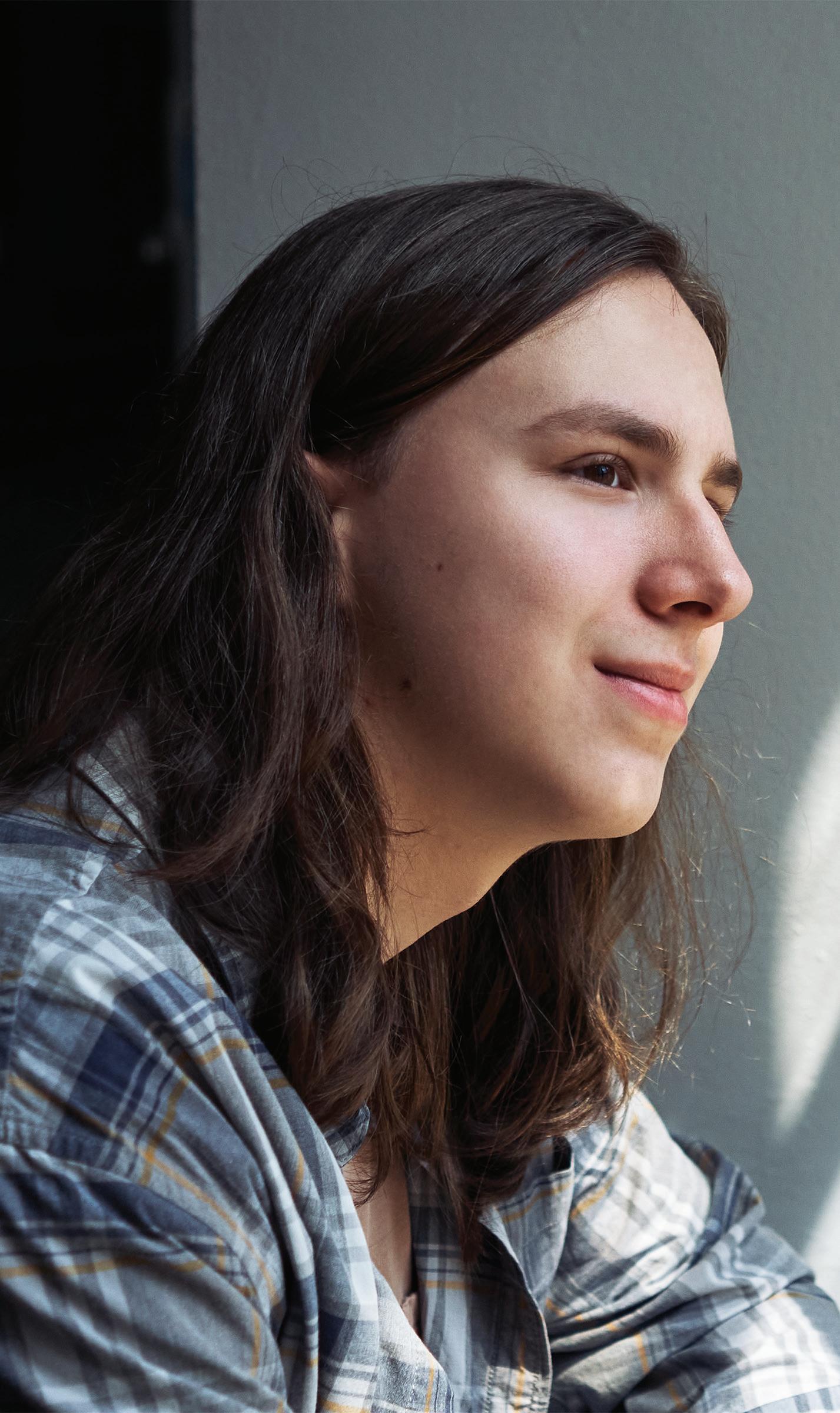
Really good at: Robotics. In his Weston Research Scholars Program project at Tech, Thomas created a mobile cloud chamber for transmitting visualizations of any radiation present at a site, by video-telemicroscopy, to observing scientists. The device is believed to be patentable. His work earned him finalist, semifinalist, and high honors in numerous competitions.
For fun: The alto sax. Thomas was in the jazz band and soloed at school concerts. He also enjoys making breakfast crepes and embroidery. Tech gave me: “I refined and combined my general interest in robotics and love of 3D printing into a specific educational and research path. I mainly credit the Weston program and my mentor, Dr. Horace Walcott.” ■
MAJOR: Mechatronics
COLLEGE: M.I.T.
BORN: Staten Island
PARENTS BORN: Staten Island
Achievement: Questbridge College Prep Scholar
Really good at: Coding: A teacher spotted her aptitude in the sophomore computer science class and encouraged her to major in software engineering. She created an online food shopping list app that prevents shoppers from inadvertently duplicating their purchases.
Tech gave me: “Tech helped me discover my passions. I didn’t know anything about computer programming when I got here.”
Why Tech rocks: The majors system: “It forces you to become an adult and start making choices. At 15, you have to choose.”
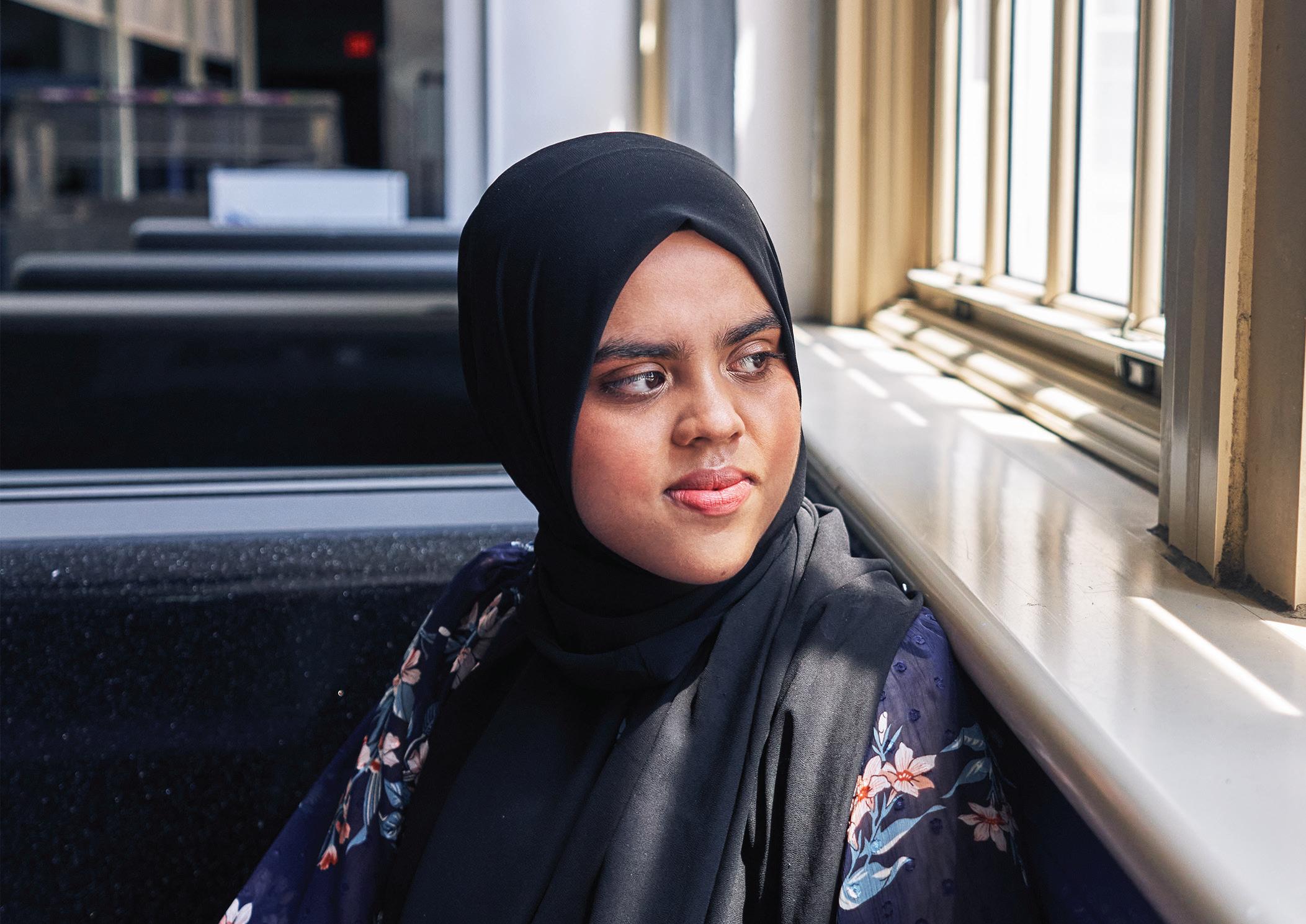
College plan: Computer science, website development.
Challenge: Entering a male-dominated industry, but “It’s important to be a woman in this field. You show others that they are capable of doing it.”
Influential book: A Thousand Splendid Suns by Khaled Hosseini
For fun: Cooking and baking, especially pasta dishes and tiramisu. ■
Really good at: A bridge-building competition in middle school hooked Nicole on civil engineering: “I chose Brooklyn Tech because it had the civil engineering major.”
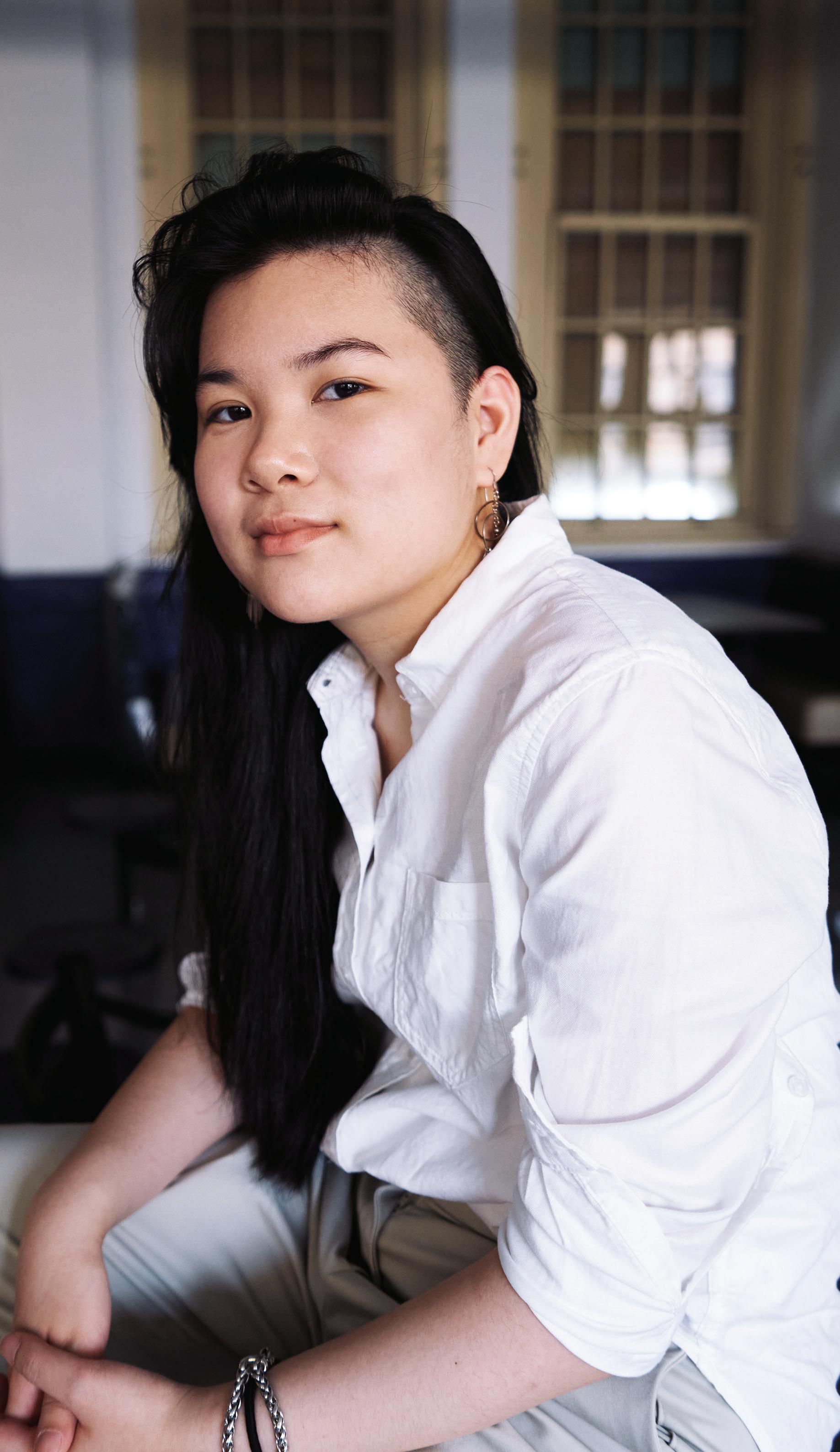
Claim to fame: A very loud voice when needed: “We survey in the park, and it’s fun to see people’s reaction when I ask them from one hundred feet away to hold the rod still.”
Best summer: Nicole, who uses the pronouns they/them, got an internship with Turner Construction through an Alumni Foundation notice. Visiting skyscraper construction sites, they’d see the skyline from up high and think, “So this is New York. This is what I want to do.”
Extracurriculars: “A lot of students joined as many clubs as possible to look good for colleges but I only volunteered and joined the clubs I genuinely cared about. Volunteering is supposed to be out of the goodness of your heart: it is giving.” Nicole was co-president of a book club and vice president of the school’s ASCE chapter.
Challenge: “It’s lonely, being one of the few girls in this major: We are all strong. I don’t think it’s fair when people say, ‘You were born this way so you should do XYZ’.”
Tech gave me: “It cemented my self confidence.” ■
PARENTS BORN: China (“I come from a very long line of farmers.”)
MAJOR: Law and Society
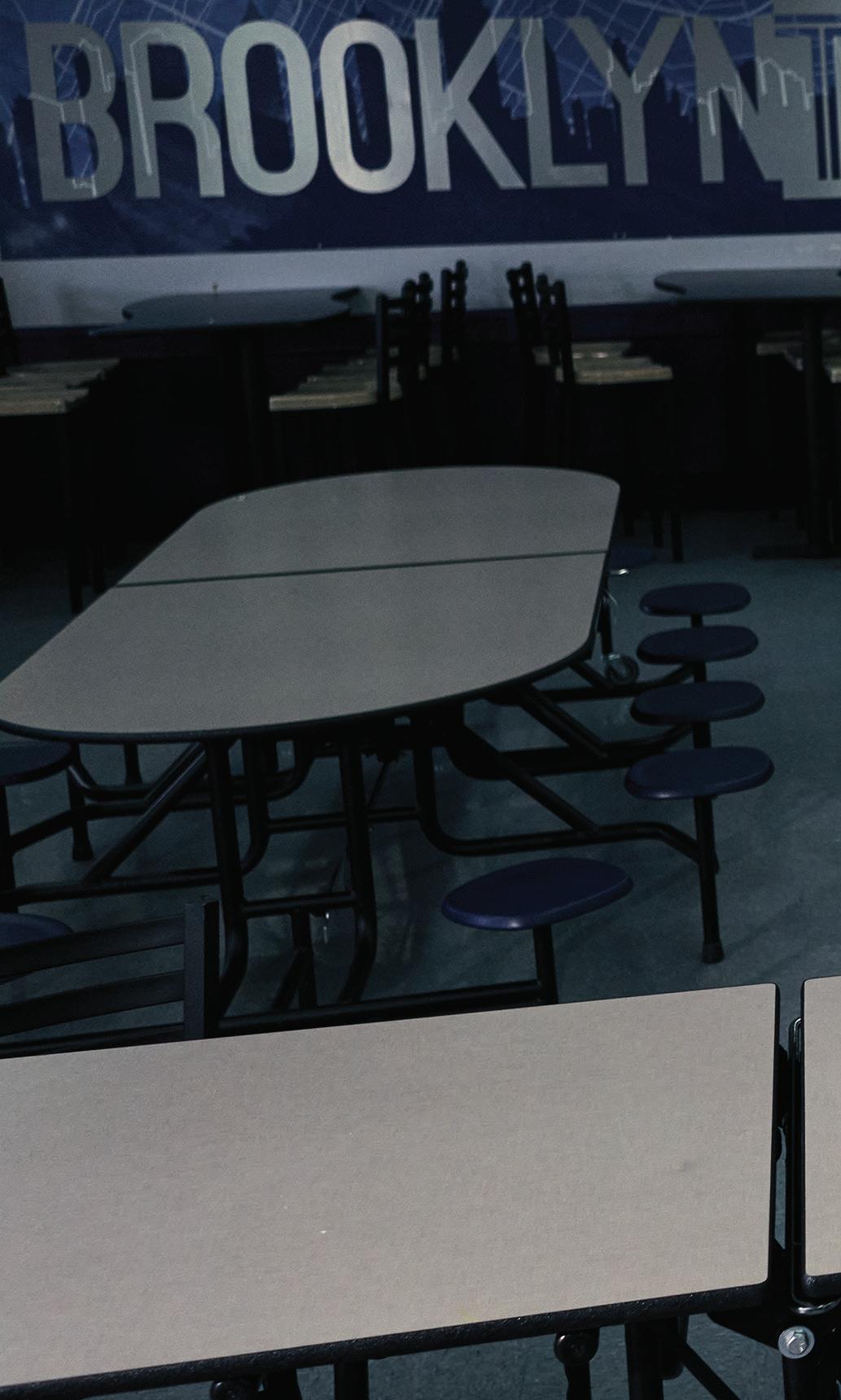
COLLEGE: Columbia
BORN: Detroit
PARENTS BORN: Pakistan
Really good at: “I’m a bit of a geography nerd. I became fascinated with global geography after taking Advanced Placement World History. Geography for me is a window into a culture. I have an eight-by-four-foot world map in my bedroom where I memorize the location of random countries when I’m bored.”
Tech gave me: “It’s made me more independent, confident and collaborative.”
Tech changed me: Ayaan entered Tech thinking he’d be pre-med or a STEM major. His
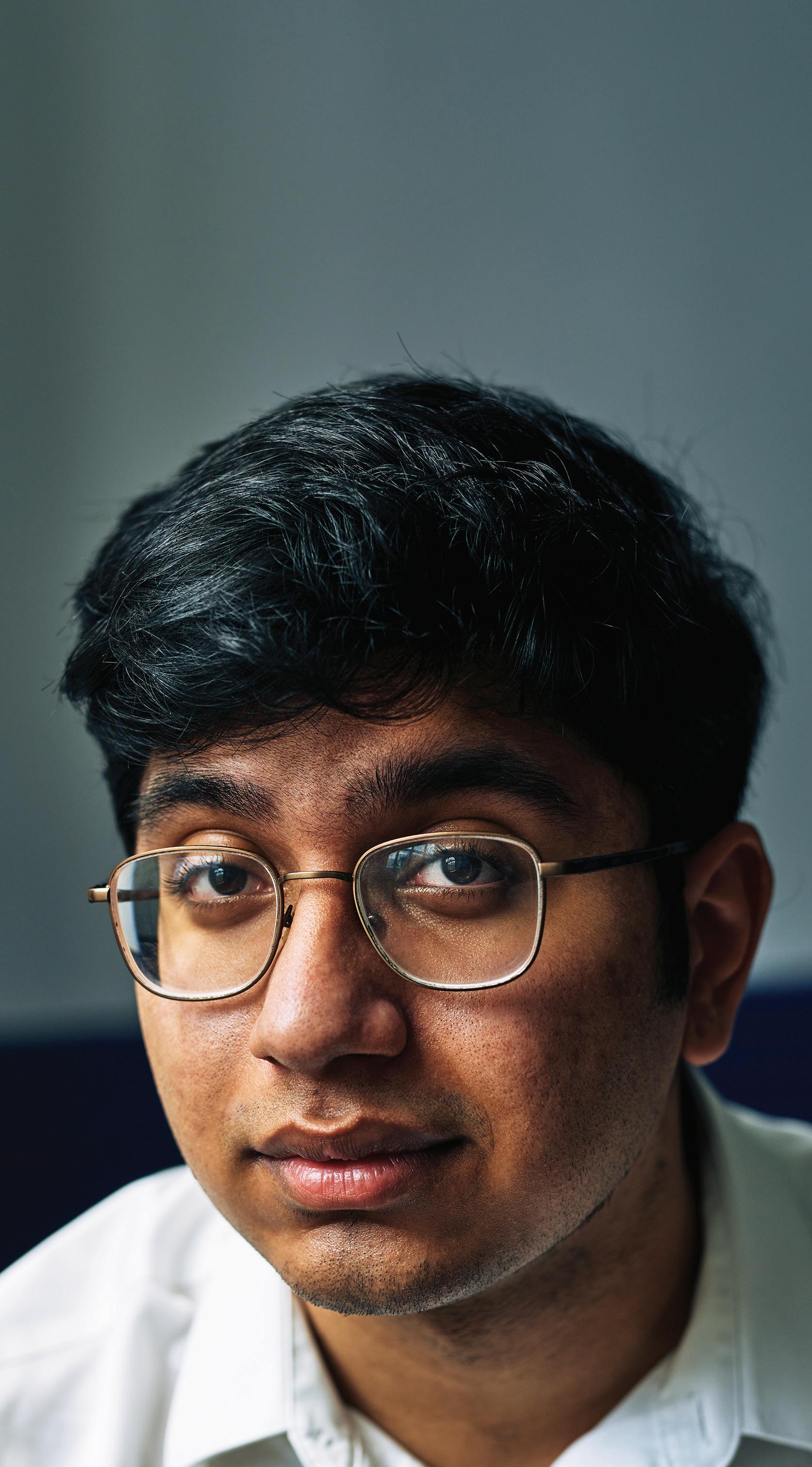
freshman English teacher spotted and encouraged his writing skills; he began writing movie reviews for The Survey and an independent film website. He became The Survey’s executive editor and has written more than 200 film reviews.
College plan: Interested in the intersection of STEM and the law, Ayaan wants to pursue a major combining those fields, then go to law school.
Influential book: The Work of Art in the Age of Mechanical Reproduction by Walter Benjamin.
Favorite Tech class: Criminal Procedure and Civil Law ■
MAJOR: Physics
COLLEGE: NYU
BORN: Manhattan
PARENTS BORN: China
Claim to fame: Senior class president. Organized and co-hosted first school virtual talent show during the pandemic: “It reached more people than it would have in person.”
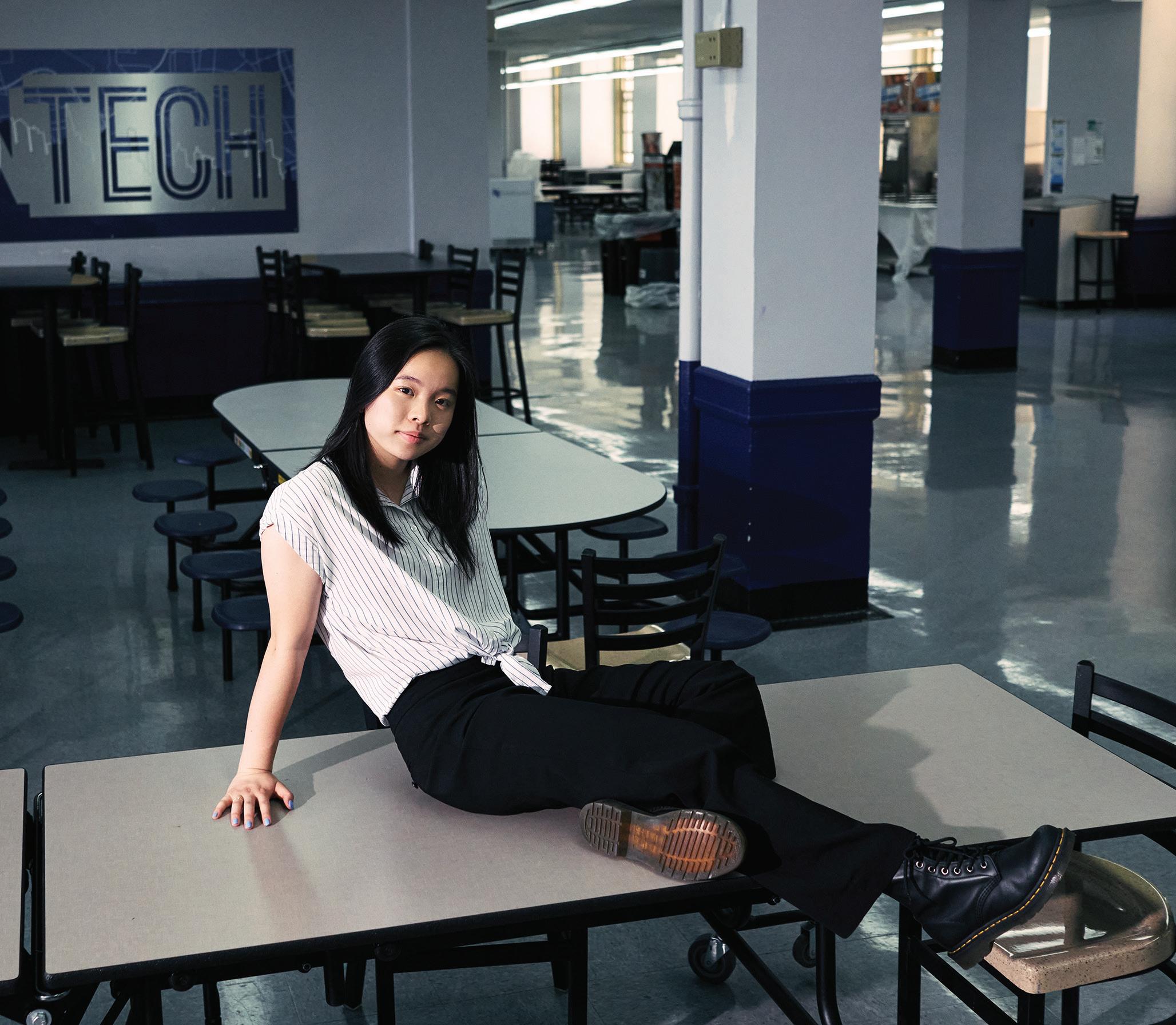
Tech gave me: The Alumni Foundation’s Con Edison internship program: “We went to an LNG plant, a testing lab and a steam plant. I got to play the part of being an engineer. I worked on something that powers New York City!”
Really good at: Physics and astronomy. Fascinated by it since age five, when she watched Stephen Hawking videos about black holes: “I don’t know how as a five year old I did that.”
College plan: “Black holes, white holes, dark matter…so much is
unexplained. I could be one of the people who help explain it.” For fun: Swimming, volleyball.
The Centennial: “I believe that my peers and I are in this class for a reason. Being the Centennial class has a different meaning to every person, and I believe it is a reminder that we are the next generation of greatness.”
Memorable Experience: As senior class president, Michelle was called upon at last June’s commencement ceremony to introduce and welcome the day’s surprise keynote speaker: President Bill Clinton. Neither she nor any of the several thousand graduates, guests and faculty knew until that morning that the former president would be present. (Michelle tells of this experience in this issue’s online bonus content package.) ■
ONE THOUSAND to fifteen hundred grads a year, 23 graduating classes since 2000: that’s 30,000-ish more Brooklyn Tech alumni since the millennium’s dawn. All (including you, dear millennial reader) amazing in their own way.
For this future-focused issue, we spotlight some of them. To see where they’re going, where they are, and how Tech helped them get there. We asked alums, faculty and staff to nominate a graduate of a 2000s class, and we narrowed it from there, to represent the exceptional talent Brooklyn Tech produces across a broad spectrum of professions and industries.
Here are ten of Tech’s many rising stars of the new millennium. Read how their Tech education set them on their paths.
Yes, that was a Technite you saw performing for Hollywood royalty and a global TV audience at the 94th Academy Awards last spring.
Dancer-choreographer Kaity ‘Kai’ Martinez was chosen by Disney as half of a duo that stylishly accompanied a Lin-Manuel Miranda song from the film Encanto, as it was sung onstage.


Kai was an obvious choice: not only has she performed with the likes of Paul McCartney, Kendrick Lamar “and everyone in between,” but she had been a force powering Encanto’s visual beauty and authenticity.
Disney, striving for cultural sensitivity and realism in creating this tale of a mythical Colombian family, had turned to Kai for a dual role during production: to craft and block the human moves that animators would replicate digitally, and to be a cultural consultant.
Working from childhood memories and old family VHS tapes, she guided the animators to capture the essence of Colombian culture. For Kai, the work was personal: a scene of the central characters partying was based on remembered times when her grandmother and uncle danced in the family apartment.
Kai’s next moves may be off the dance floor: she’s getting into directing music videos (an art she first explored at Tech as a media major), and hopes to direct a screenplay. ■

Eric Tan found his life work and his life partner at Brooklyn Tech.
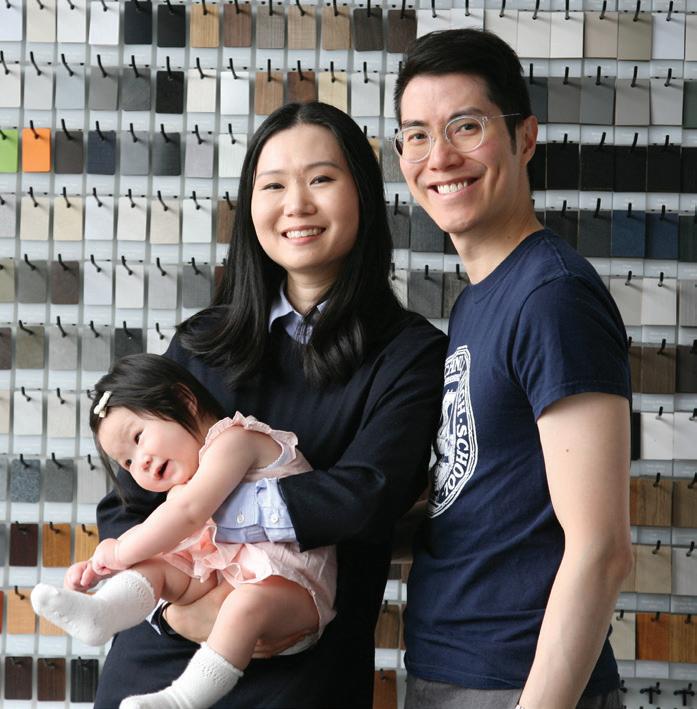
The partner is Judy Yuen ’04, a speech pathologist. The work is architecture.
A senior architect at ZGF Architects, Eric’s passion is the intersection between architecture and urban planning. By age 30, he had cracked several lists of New York’s top young architects, had a project exhibited at the Museum of Modern Art, and won a South by Southwest (SXSW) award for innovation and sustainability.
Eric, who arrived in the US at age four knowing no English, got hooked on architecture through an internship Tech found for him. “Architecture,” he says, “is a compelling combination of the arts and engineering.”
After working on a new headquarters for Amazon in Virginia, he is now on the design team for the nation’s first cybercommand headquarters, a massive half million square foot structure, for the U.S. Department of Homeland Security.
Eric believes his formative years in Tech’s architecture program led to this direct role in the effort to protect the nation’s critical infra structure from physical and cyber threats. ■
It’s an old story: not a lot of women in the technology sector.
Hooked by Tech’s introductory computer science course, Radhika Kalani signed up to major in software engineering. The first day, “There were maybe five females in a class of 100. I thought, I’m not sure I’m in the right space.”
But one of those five approached her with support, and “I thought, OK, why not, I’m passionate about this. I want to see where it goes.”
It has already gone far for Radhika, now two years out of college. She is a product owner and business analyst at Blackstone, the world’s largest alternative asset manager. (A product owner in a technology business manages the product development process to ensure that stakeholders’ needs are met.) Radhika’s work involves automating the financial calculations that help keep Blackstone’s myriad funds humming.
Studying computer information systems at Baruch College, Radhika had landed a Blackstone internship that led to her current job. Along the way she cofounded Global Girlhood, an online community for empowering women.
An entire career lies ahead, its exact path not yet known. But Radhika has set her goal: “Being able to help people through technology.” ■

Paris Fashion Week, home to le monde superchic establishment, (Hermes, Chanel, Dior), also showed the creations of one of the planet’s buzziest designers – a Brooklyn Tech math major alum who started out selling T-shirts in the cafeteria.
Meet Colm Dillane, the supercharged force behind KidSuper, who WWD tagged last year as “fashion’s next breakthrough star.”
The New York Times has profiled him. Marc Jacobs wore him in a video. He won the prestigious LVMH Karl Lagerfield award, given to a young designer “whose creative talent has seduced the Jury.” The Metropolitan Museum of Art displays him. He has dressed Jay-Z, Lil Nas X, and Dua Lipa.
How did all this happen? No mystery: He’s fresh, colorful and playful. The KidSuper line evokes “a childlike sense of wonder and mischievousness,” Colm says. The fashion world bought in big time.
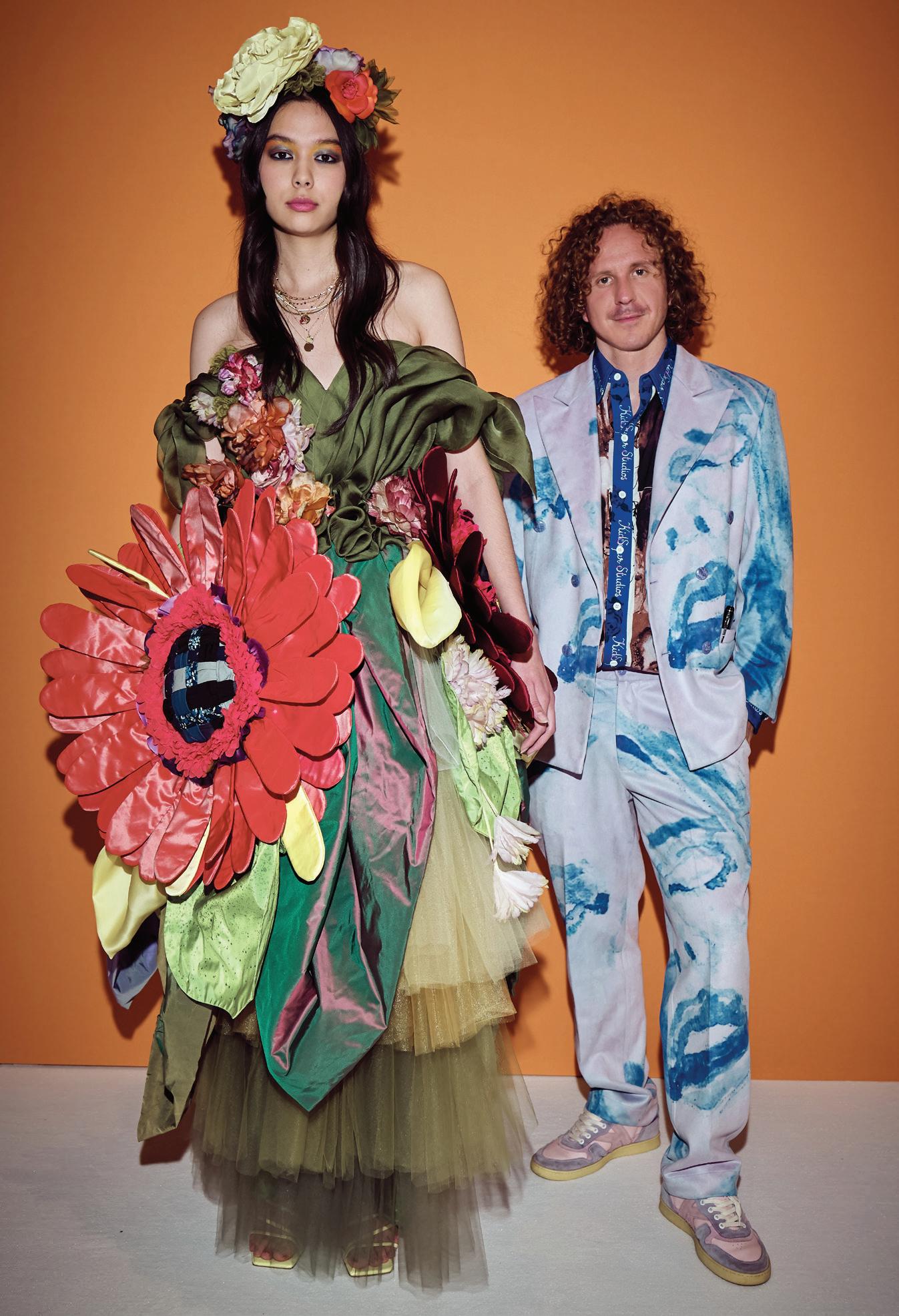
KidSuper has become a multimedia brand producing music videos, art shows and collaborations with star performers. It’s finishing a giant new studio in Williamsburg, echoing the spirit of Andy Warhol’s Factory, to house it all.
But Brooklyn Tech math started him: “It taught me an innate ability to problem solve, to step into new worlds and figure out what to do.”
PS: It didn’t hurt that his Tech cafeteria T-shirt line was a big success. ■
Load the paper tray before printing David’s resume: this West Point graduate has seven higher education degrees, serves as a Lieutenant Colonel in the Army Reserves, and is a global pharmaceutical company executive.
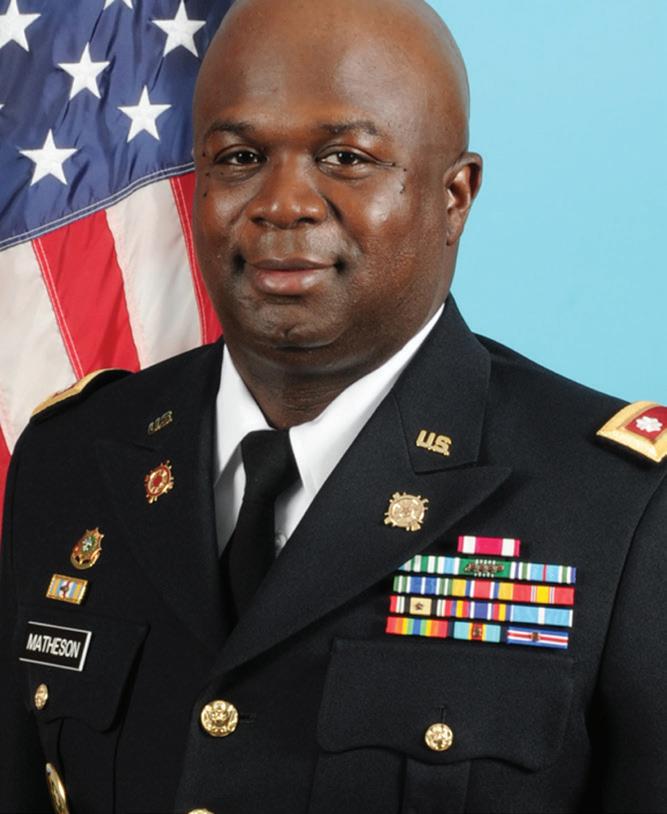
After nine years of active military service including a combat tour in Iraq, David entered the Reserves where he is now a battalion commander responsible for 700 Reservists. His civilian job: overseeing Covidrelated programs and supporting other business-critical initiatives for a Covid vaccine manufacturer.
For the record, those degrees: BS (West Point), MSIR (Troy U.), MBA (Boston College), MPH (U. of North Carolina - Chapel Hill), EdD (U. of Southern California), MMS (Air University) and EMHA, (Cornell U., Fall 2022).
Next up, number eight: a planned PhD in evidence-based healthcare at Oxford. David’s dissertation will examine how healthcare leaders and government can effectively communicate the importance of vaccines.
Why all this education, David?: “To seek an elevated level of understanding of the intricacies of this world, while aiming to self-actualize and help millions of others find their best selves.”
BTHSBTHSBTHSBTHSBTHSBTHSBTHSBTHSBTHSB

Crystal Walthall identifies herself as a “non-profit executive, educator, changemaker.”
Crystal is executive director of Faith in New York, an affiliate of the national organization Faith in Action. Multi-faith and grassroots, Faith in New York engages religious leaders and community members in community organizing on such issues as voting and immigrant rights through a lens of faith and justice. Her organization equips these groups with training, resources and legislative analysis. During the pandemic, its work intensified with programs that funders noticed: Her organization grew at a time when many others retrenched; staff nearly tripled. “We dug into what we do well, which is centering the needs of directly impacted communities in defining their own vision for change,” Crystal explains.
Strategies learned at Tech two decades ago, in student government and in class, (a paper she did on Black churches pointed to her eventual professional path) guide her work to this day.
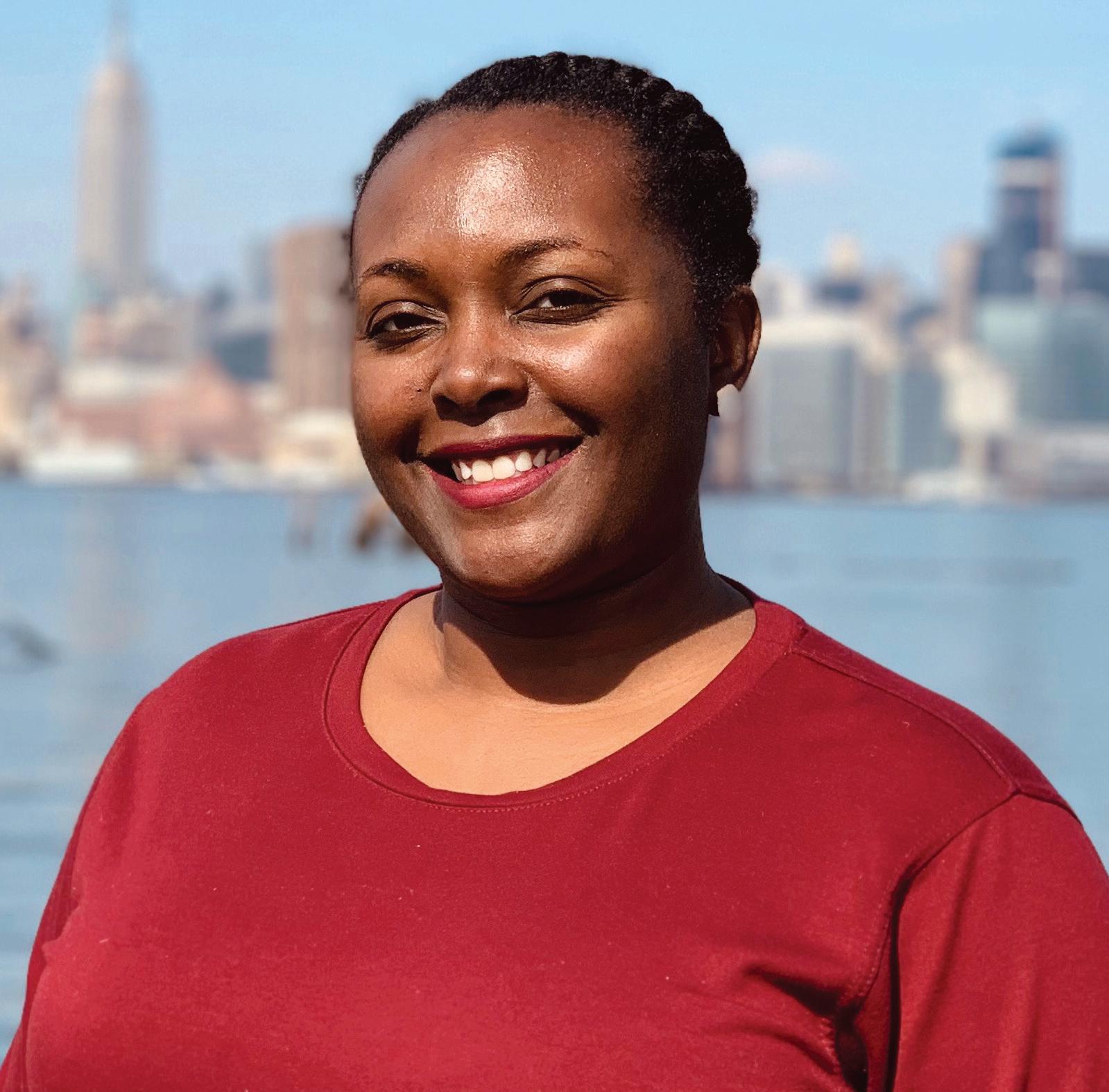
“I want to change conditions for the next generation, so people won’t have to experience the things I experienced,” she says. ■
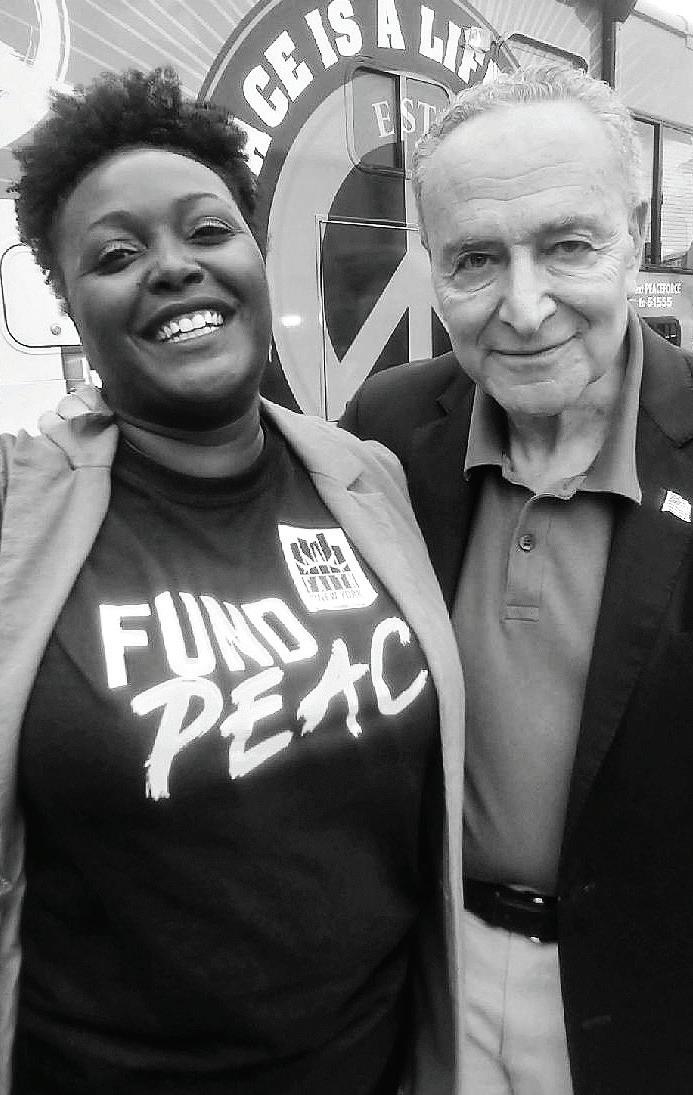
Taking swim lessons at age five, little Enrico leaned into underwater swimming: “It felt like flying.”
It started there. Enrico grew fascinated with airplanes, so at Tech he majored in…… Law and Society? (“People told me it was harder so I said, I can do it.”)
By college, aerospace would be his major – at the U.S. Naval Academy, with its 7% acceptance rate. Unlike the Air Force, Navy pilots land on waterborne carriers – way cooler, he thought.
Enrico graduated the Academy in 2020 and is now advancing through ever more demanding flight training levels. He is scheduled to become a full pilot – a winged aviator – this fall, followed by another year of even more challenging training. Then he will fly an F/A-18 Super Hornet – like the Blue Angels – or a similar aircraft.
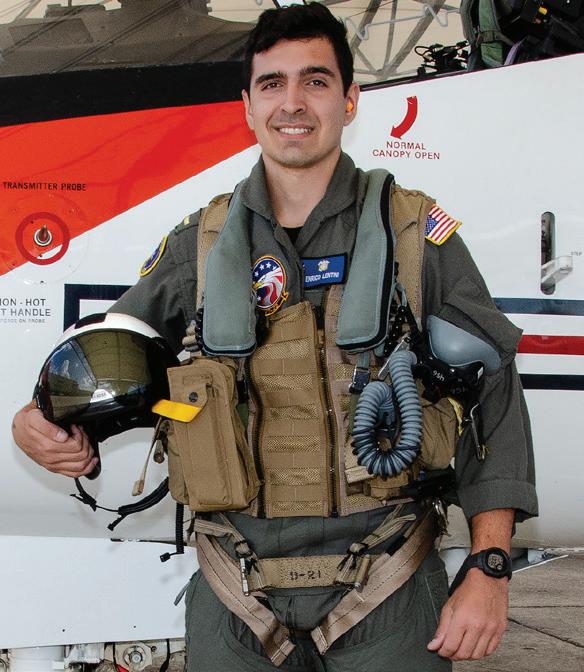

He flies every other day for about 90 minutes: “It’s like no other feeling. It can be uncomfortable and exhausting at times, but it is super exciting.”
With a strong aero engineering background, Enrico hopes to become a test pilot. Astronaut? Not out of the question. “I’m living my dream job,” he says. “It wouldn’t have been possible without the people who believed in me.”
Marva Tariq holds a highly competitive National Science Foundation fellowship that fuels the passion she discovered at Tech: lab research in synthetic organic chemistry.
The lab in question is at California Institute of Technology, where Marva is pursuing a Ph.D and planning for a career in either academia or pharmaceutical research.
“I wouldn’t have fallen in love with doing chemistry research if it hadn’t been for the Weston Research Program at Tech,” she says of the Alumni Foundation-funded initiative.

Marva originally planned to become a physician. Then she learned of the Weston research program: “I realized I could help people behind the scenes as a scientist.”
Her current research pursuit: “The synthesis of small molecule natural products that have therapeutic applications for cancer and other diseases.”
Marva is already making a difference: her undergraduate (Smith College) professor called her “an incredible partner” who mentored classmates and advocated for equity and inclusion initiatives. ■
Fresh out of Yale Law School, Shariful Khan’s immediate future is carefully mapped. For the next two years he will hold a prestigious Skadden Fellowship in public service law, litigating civil rights cases on behalf of children nationwide. He will then clerk at the United States Court of Appeals, Tenth Circuit, and the Southern District of New York.

It is the purposefully charted path of a legal star on the rise, with an aim: serving those in need through law.
Already, as a law student, Shariful has: sued the US Air Force for discriminatory
treatment of disabled veterans; co-founded an organization to guide underrepresented people into law school; and mentored firstgeneration and minority law students.
Shariful’s parents, immigrants from Bangladesh, led by example: active in their community, “They always prioritized looking out for those who had less than even they did,” he recalls.
At Tech, influential teachers and the Law and Society major with its moot courtroom solidified his direction: “I’ve only gotten this far because of those who have supported me along the way. I hope to return the favor by helping empower communities for years to come.”
Acclaimed photographer and emerging film director An Rong Xu creates images that vibrate with humanity, radiating a bold immediacy of person and place. His work, the photo publication MUSÉE wrote, “is rooted in the beauty of the ordinary.”
Often, An Rong finds that beauty in his own culture and identity: Asians and Asian Americans. The New York Times, The New Yorker and Rolling Stone are among the prestige publications that publish his work. Photoville, the Brooklynbased outdoor photography festival, displayed his riveting portraits of his late grandfather.
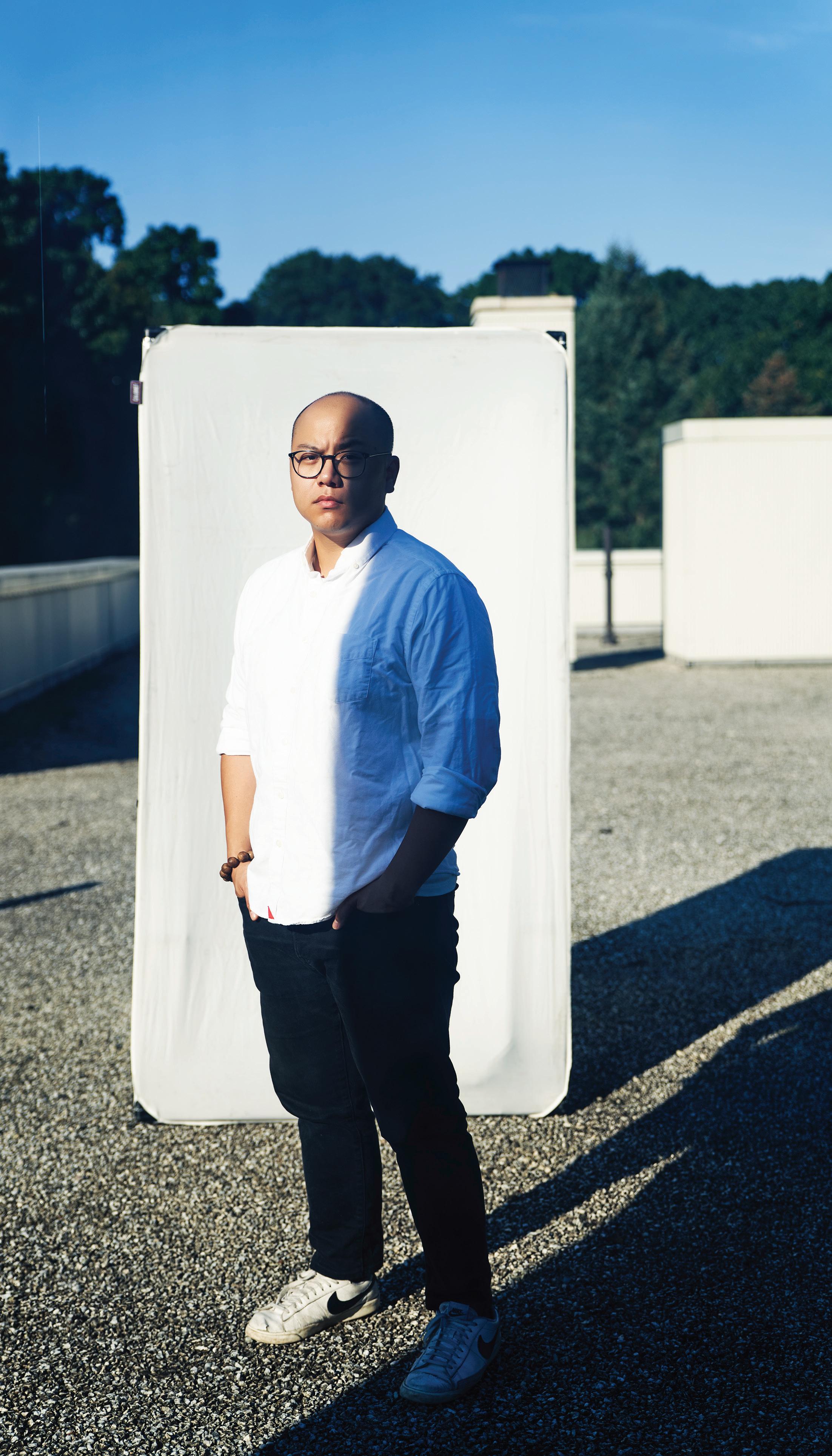
It started for An Rong at Brooklyn Tech through…..the football team?
Rebounding from a rocky middle school tenure, he joined Tech’s squad: “It made me comfortable with who I am. It showed me the level of dedication it takes to succeed at something.”
Self-described mediocrity at graphic design in the media communications major ensued, but along the way he picked up a camera and “I started seeing differently. I felt empowered.”
A friend told him, “I don’t think you’re a graphic designer – but a photographer? You might be able to do that.” An Rong headed off to the School of Visual Arts, and the rest is history.
See An Rong’s portraits of Tech’s Centennial Class members starting on page 12. ■
NEW FACES ABOUND on the Alumni Foun dation staff team this fall, and they’re here to serve you and the students of Brooklyn Tech.
Courtney J. Ulrich ’90, or CJ as she is known in Tech circles, is thrilled to join the Foundation as executive director, bring ing more than 20 years of non-profit experience in cultural and educational management and development.
Courtney has spent her career supporting the arts and education and is dedicated to creating access to high-quality public educa tion, and empowering people of all ages and backgrounds in their pursuit of excellence. She is well known within the Tech community for her work ethic, passion, leadership capa bilities, and capacity for growth.
Previously, Courtney served as the di rector of principal gifts at Brooklyn College Foundation, where she raised millions of dollars in support of students and faculty. She also raised significant funds to support capital improvements and special initiatives for the college.
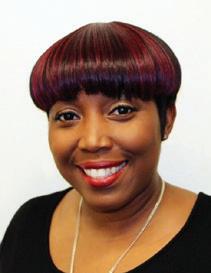
Courtney received her master of fine arts from Parsons School of Design - The New School, and her bachelor of fine arts from the California College of the Arts.
Joining as director of alum ni engagement is Michelle Corley. She’s the person who will constantly invite you to take part in our activities, and make it a rewarding experi ence when you do.
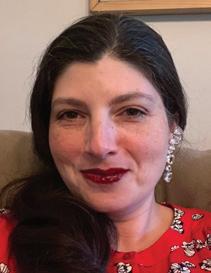
Michelle comes to us from the Baruch College Alumni Foundation. She has a bach elor’s degree in business administration from York College, CUNY, where she serves as a trustee on their foundation board. Michelle is a graduate of New York City’s famed LaGuar dia High School. She is responsible for culti vating relationships with alums from diverse backgrounds that strengthen their bond to their alma mater.
Our new director of data and analytics is Leticia VillalónSoler, with more than 20 years of experience in nonprofits and a background in law, nonprofit administration and international relations. Leticia’s role is to maintain and deploy our alumni family data base in the service of our programs, donors and alumni.

The team is rounded out by chief edu cational officer Matt Mandery ’61, who develops the extraordinary Foundation pro grams that enrich the Tech educational ex perience; chief development officer Marcel V. Vaughn-Handy; and director of commu nications Lisa Trollback. Former executive director and Tech icon Liz Sciabarra is now special advisor.
Continued from page 5
sorts of instruments, new and old. These range from global monitoring of methane releases into our atmosphere to monitoring characteristics of supernovae explosions in distant galaxies.
In astronomy, on a small scale, there have been for well over a decade, small optical tele scopes distributed around the world, which are controlled remotely and operated by high school students to take pictures of specific parts of the sky and analyzed in a variety of ways with sophisticated software. This network could relatively easily be extended to students in more high schools and, appropriately, to those in elementary and junior high schools. Soon to become operational are large tele scopes, which will enable pre-college students to access digitally a wide variety of top-of-theline observations of the cosmos and software to analyze them, all essentially in real time.
There is also the burgeoning field of artifi cial intelligence (AI), which will likely come into strong play on such issues as what and how to store massive amounts of data for easy access and analysis. These issues will be considered and solved at levels beyond high school, with the solutions utilized at the high school level and likely below.
What about Brooklyn Tech now? What changes will likely help its students better pre pare? Whereas I had definite ideas on what should have been done to further STEM edu cation when I attended Tech in the mid-1940s, I have far less familiarity with today’s Tech curric
Continued from page 5
considerations in all that one does; and Systems thinking: recognizing and con sidering how systems are connected in complex ways and how changes to parts of a system can have ripple effects.
These habits of mind are as relevant to to morrow’s historians and artists as they are to future epidemiologists, robotics engineers, and all of those yet-to-be-conceived careers.
From the industrial age to the digital age, Brooklyn Tech has cultivated these habits of mind through hands-on, minds-on majors and course offerings. From designing industrial products to investigating how law shapes so ciety, Tech has helped students exercise their creative vision, investigate and debate com
The Alumni Foundation thanks now-re tired staff members Ina Cloonen and Sue Hausman for their many years of dedicated service. ■
GET TO KNOW THE TEAM…. Click to our online bonus package for some fun facts about Courtney, Michelle, Leticia and the staff’s veteran members.
ula and so likely no relevant suggestions. But I will make a few anyway.
I am very pleased that Tech, which did not offer a single course in biology when I attended, now has a very modern, well-equipped biology department and an excellent curriculum. I say this based mostly on having seen, on a visit a few years back, some of the biology laborato ries and of the use Tech is making of them. I ex pect there are similar good setups for technical and engineering disciplines.
The mathematics curriculum has made great strides since the 1940s, but I believe can ben efit from further improvements. As the needed knowledge among teachers becomes available, I would like to see courses added in such sub jects as complex variables, real analysis, and elementary topology.
And I must stress that the BTHS Alumni Foundation, its loyal base of Technites and its dedicated and wise leaders, enable Tech to keep up to date in many areas where funds from the city are not forthcoming in needed amounts.
Other high schools might well try to emulate Tech’s successes in the STEM fields, perhaps also making use of vibrant alumni associations.
I thank Ned Steele for his excellent work ed iting this short article. ■
Irwin Shapiro is the Timken University Professor at Harvard University and a senior scientist at the Smithsonian Institution.
plex issues, consider the ethics of their ac tions, and design solutions to problems worth solving.
Tech can continue this tradition through an ongoing commitment to building students’ re silience in the face of change to become the innovators of the future. ■
Learn more about the American Association of Engineering Education’s Framework for P12 learning: https://p12framework.asee.org.
Dorothy Bennett, Director of Creative Pedagogy at the New York Hall of Science, has worked in educational media and science education for 35 years.
$1,000,000 +
Isaac Heller ’43*
Norman Kurt Keller ’54
Leonard Riggio ’58
Leandro P. Rizzuto ’56*
Charles B. Wang ’62*
Floyd Warkol ’65
Josh S. Weston ’46
John A. Catsimatidis ’66
James T. Fantaci ’64
Fred M. Grafton ’44*
Victor Insetta ’57
Achilles Perry ’58
Ashok Varadhan ’90
Erik Klokholm ’40*
Mary Jane* and Richard H. Schnoor ’49*
$100,000 +
David H. Abramson ’61
Gregg Abramson
Harold Antler ’46*
Peter J. Cobos ’72
Charles A. DeBenedittis ’48
Susanne D. Ellis
Jacob Feinstein ’60*
Howard Fluhr ’59
Jeffrey M. Haitkin ’62*
Herbert L. Henkel ’66
Stuart Kessler ’47*
Alfred Lerner ’51*
Richard Mack
Stephen C. Mack
Frederick C. Meyer ’40*
Michael F. Parlamis ’58*
Lee James Principe ’56*
Louis H. Siracusano, Sr. ’60*
George J. Suffal ’53
Thomas J. Volpe ’53
Michael A. Weiss ’57
$50,000 +
David Abraham ’48
Martin V. Alonzo, Sr. ’48* Willard N. Archie ’61
John Arfman
Anthony J. Armini ’55
Lawrence A. Baker ’61
Larry Birenbaum ’65
Joseph M. Colucci ’54
Robert F. Davey ’58
Peter A. Ferentinos ’55
Penny Haitkin
Lawrence S. Harte ’49
Joseph J. Jacobs ’34*
Joseph J. Kaminski ’56
Richard M. Kulak ’56*
Rande H. Lazar ’69
William L. Mack ’57
Michael Minikes ’61
Carmine A. Morano ’72
Robert C. Ochs ’59
Sherman Rigby ’46*
Edward R. Rothenberg ’61
Alan M. Silberstein ’65
$25,000 + Martin V. Alonzo, Jr., Marlene Alonzo and Sabrina Alonzo
Joseph Angelone ’63
Anthony Bartolomeo ’70
Douglas Besharov ’62
Robert H. Buggeln ’57
Larry Lee Cary ’70*
Dorcey Chernick *
Louis C. Cosentino ’61
Kenneth D. Daly ’84
James DiBenedetto ’71
John di Domenico ’69
Leonard Edelstein ’55
John J. Eschemuller ’65
Keith Forman ’76
Andras Frankl ’67
Jason Haitkin
Alice C. Hartley *
Eric Kaltman ’60
Penelope Kokkinides ’87
Franklin F. Lee ’77
Glenn Y. Louie ’59
Lawrence C. Lynnworth ’54*
Mathew M. Mandery ’61
Robert Marchisotto ’47*
Betty J. Mayer *
Arnold J. Melloy ’40*
Margaret Murphy ’83
Murray H. Neidorf ’45*
Bert Reitman ’63
John B. Rofrano ’61
Patrick Romano ’43*
George E. Safiol ’50
Harry Scheuer ’48
Anthony P. Schirripa ’67
William Sheluck, Jr. ’58*
Richard Schwartz ’53
John C. Siltanen ’31*
Lawrence Sirovich ’51
Ned Steele ’68
Chester Wong ’94
William H. Wong ’64
Wellington Yee ’67
$10,000 +
Jeanine Aguirre-Ramirez ’88
Frederick Haig Ajootian ’41* Mark Arzoomanian ’83
Jean M. Bahr Emanuel Becker * Cindy Lee Bird-Kue ’86
Harry H. Birkenruth ’49
Samir K. Bose *
LeRoy N. Callender ’50 Wilton Cedeno ’82
Calvin Chin ’84
Nicholas Y.L. Chu ’77 John V. Cioffi ’67
Peter J. Coppolino ’61
William A. Davis, Jr. ’59
Thomas C. DeCanio ’63
Elizabeth Decolvenaere ’08
Alfonso D’Elia ’67
Robert J. Domanoski ’47* Murray Dropkin ’62 Jonathan D. Dubin ’74 Jeff Erdel ’63
Charles D. Federico ’47 Richard R. Ferrara ’59 Victor M. Finmann
Bernard R. Gifford ’61
Jeffrey L. Goldberg ’69
Robert J. Golden ’63 Jacob Goldfield Domingo Gonzalez ’72
Eugene J. Gottesman ’47 George Graf ’70
William H. Henry ’57 K. Steven Horlitz ’64 Joy H. Hsiao ’87 Michelle Y. Johnson-Lewis ’79
Edward H. Kadushin ’57 Charles Kyrie Kallas ’37* Leslie P. Kalmus ’56
Steve H. Kaplan ’63 Sheldon Katz ’52 Elizabeth Korevaar Eliza Kwong ’93
Edward T. LaGrassa ’65
Richard E. LaMotta ’60* Salvatore Lentini ’79
Michael Levine ’61
Stephen J. Lovell ’57
John M. Lyons ’66*
James H M Malley ’58
Sidney A. Mayer ’46* Susan J Mayham ’76* Ellen Mazur Thomson Patricia Vasbinder* and Victor B. Montana ’60* George W. Moran ’61 John Moy ’58
Shana Mummert
John R. Murphy ’61
Michael D. Nadler ’52
Alan S. Natter ’69
Hau Yee Ng-Lo ’80
Floyd R. Orr ’55
Bola Oyedijo ’92
Eugene Picone ’76
Michael George Reiff ’72
Daniel K. Roberts ’43
Edward Roffman ’68
Charles J. Rose ’70
Robert Murray Rosen ’51*
William J. Rouhana, Jr. ’69
Edward P. Salzano ’64
Roger E. Schechter ’70
Alfred Schroeder ’46
Phyllis Scroggie
Irwin Ira Shapiro ’47
Moshe Siegel
Roy B. Simpson ’41
Barry Sohnen ’70
James Spool ’46*
Jonnie* and Ralph H. Stahl ’45*
Daniel Stahl
Robert J. Stalzer ’59
Ronald P. Stanton ’46*
Stuart Subotnick
Joseph N. Sweeney ’48
Michael Tannenbaum ’58
Daniel Tomai
Wesley E Truesdell ’46* Armand J. Valenzi ’44
George L. Van Amson ’70
Salvatore J. Vitale, Jr. ’56
Ralph B. Wagner ’51
Louis Walkover ’37*
Denice Clarke Ware ’83
Stephen Weinryb ’75
Anre Williams Steven Wishnia ’66
Douglas Yagilowich ’76 Peter Yan ’88 Randi Zinn
$5,000 + Kenneth R. Adamo ’68 Irving Adler ’61 Ron S. Adler ’68
Louis G. Adolfsen Kenneth S. Albano ’68 Michael A. Antino ’60 Joseph F. Azara, Jr. ’64 Donald Bady ’48 Rudolph Bahr, Jr. ’41* Randell Barclay Eric D. Barthell ’75 Kay and Jim Benjamin ’80 David J. Bershad ’57 Theodore Bier Syd Blatt
Ronald Blum ’67 Anthony Borra ’58 Mariano Borruso ’71 Thomas Breglia ’76
Robert B. Bruns ’55 Charles Cahn, Jr. Dominic N. Castellano ’45 Joseph A. Cavallo ’58
Sylvia Cember *
Samuel David Cheris ’63 Robert J. Ciemian ’59 Jose R. Claxton ’82
Leonard B. Comberiate ’69 Deirdre D. Cooke ’80
Brian Cosgrove
Pat and Joseph L. Cuzzocrea, Sr.
Kenneth D’Alessandro ’66 James E. Dalton ’49
Fred M. del Gaudio ’71
Frederick DeMatteis ’40*
Lucia DeSanti
Edward Diamond ’63 Ronald T Diamond Robert C. DiChiara ’63 Robert H. Digby ’61
James Dimon
Robert W. Donohue ’60* Mary-Jean Eastman Margery Elfin
Barry D. Epstein ’58
Domenick J. Esposito ’65
Samuel Estreicher ’66
Murray Farash ’52
Arthur A. Feder ’45
Robert Femenella ’72
Al Ferrara
Terry Fishberg
Clifford H. Fisher ’59
Keith Franklin ’78
David L Fung ’81
Arnold Goldman ’73
Adrienne D. Gonzalez ’94
Herbert A. Granath ’48*
Kenyatta M. Green ’89
Michael Greenstein ’65*
Robert Gresl ’46*
Arnold Gruber ’59
Mario Guerrero ’86
Ronald D. Haggett ’54
William L. Haines
Steven A. Hallem ’72
Konrad E. Hayashi ’73
Carl Erik Heiberg ’92
Robert J. Heilen ’53
Gordon H. Hensley ’47* John Hensley
Christopher Hong ’09
Clifford A. Hudsick ’61
Frederic H. Jacobs ’65
John Jarrard
Allan C. Johnson ’28*
Gerard Justvig ’75 Peter Kakoyiannis ’65 Nancy, Mitch, Ernie and Felix Kaye
Arthur H. Kettenbeil ’67*
Carl H. Kiesewetter ’55
Kiseon Ko
Eugene V. Kosso ’42 Bert Krauss ’50
Costantino Lanza ’72 Chester Lee ’66 Victor Lee ’66
Danny Lee-Lap ’91
Joel F. Lehrer ’48
Marvin J. Levine ’65 Sidney Levitsky ’53 Nathan Lipke ’92 John Liu ’98
Raymond M. Loew ’58 Carol Loewenson
Thomas Lowry ’ Joel O. Lubenau ’56
Richard R. Lukaj ’87
Frank Robert Luszcz ’61 Taahira Maynard ’99
Stephen Mazur Ira Meislik ’61
Steven D. Menoff ’72
Michele Meyer Edward D. Miller ’56* Joseph Montalbo ’74
Francis C. Moon ’57
Alfred J. Mulvey ’67 Clyde Munz ’74 Kaeisha T. O’Neal ’99
Stanley H. Pantowich
Robert J. Paterna ’72 Robert J. Pavan ’47
Regina M. Pitaro
Emanuel Polichronakis ’68 Lee H. Pomeroy ’50*
Jeff Porrello
Valentine P. Povinelli, Jr. ’59 Robert Puccio Bertram Quelch ’45*
Jonathan Riegel
Joan Riegel
David Rios
Edward M. Rosensteel ’74 Herb Ross ’41
Randi Rossignol
Robert R. Rowe ’45* Lawrence G. Rubin ’43
Dan M. Ruesterholz ’56
Richard K. Ruff ’58
Seth Ruzi ’76
Erwin L. Schaub ’46
Roger E. Schechter ’70
Charles H Schmidt ’70
Ernest R. Schultz ’25*
William B. Siegel ’66
Leon C. Silverman ’57
Michael Simpson ’90
Irwin Smiley ’46*
Jonathan David Smith ’80
Richard E. Sorensen ’60
Mitchell E. Stashower ’83
Ivan D. Steen ’54
Robert C. Stewart
Robert Sumanis
Jacob Tapper
Peter M. Taras ’77
Richard S. Taylor ’57
John Thonet Mike Trovini
Richard W. Turnbull ’69
David W. Wallace ’42
Craig A.C. Westcarr ’88
Kenneth M. White
Elizabeth M. Wieckowski ’79
Samuel Wiener
Grayling G. Williams ’76*
Russell P. Wong ’79
William C. Wurst ’67
George A. Yabroudy ’48
Joni A. Yoswein
Lloyd Zeitman ’69
Barry Zemel ’64
Laurie Zephyrin ’92
Erwin A. Zeuschner ’53
Wei-Jing Zhu ’86
Air Products
Alfa Piping Corp
American Express Foundation
B T Alex Brown
BDO Seidman, LLP
BNY Mellon Bonanza Productions Inc Brooklyn Nets Brooklyn Tech High School
BTHS Alumni Long Island Chapter
BTHS Parent Association, Inc Burson-Marsteller
C. R. Bard Foundation
Care2
Cary Kane LLP Cellini Fine Jewelry Ceramax Co., LTD
Charles B. Wang Associates, Inc.
Charles B. Wang International Foundation
Chase Manhattan Bank Chicago Bridge & Iron Company
Cirocco & Ozzimo, Inc Computer Associates International, Inc
Con Edison Construction Resources Corp of New York Council for Specialized Public
HS Cowles Media Foundation
Credit Suisse Securities
Daikin Applied Deutsche Bank
Duggal Color Projects, Inc
Eastern Metalworks of NY, Inc
El Paso Energy Foundation
FIRST GameStop Corporation
Gateway Institute for PreCollege Education Gatorade Company
GIBC Digital GiveSmart US, Inc
Goldman Sachs & Co, Matching Gift Program
Goldman Sachs Gives Annual Giving Fund
Haights Cross Operating Company
Heritage Mechanical Services, Inc
Hines Interests LP - East Region
IBM Ice Air, LLC
Ingersoll Rand InnoCare Services Company LLC
Itron
ITW Foundation
Jaros Baum & Bolles
John Wiley & Sons, Inc
JPB Foundation
Keyspan
KSW Mechanical, LLC
Laura Berdon Foundation
Liberty Science Center
Lucent Technologies
M & I Electric Industries, Inc
Mancini Duffy Marathon Bank
Math for America
May & Samuel Rudin Family Foundation, Inc
MBS Textbook Exchange
Merrill Lynch & Co Found Metromedia Company
Microsoft Miller Proctor Nickolas Inc. National Basketball Association
National Grid USA NYC
National Hockey League Foundation
National Society of Black Engineers
New York City Urban Debate League
New York State Stem Grant NYStaffsearch
Octagon
P.J. Mechanical Corp
Paul, Weiss, Rifkind, Wharton & Garrison Pennoni Associates, Inc Pension Review
Piper Sandler Polytechnic University Raytheon Company
Related Construction Holdings, LLC Ridgewood Foundation Ridgewood Savings Bank Robinson Silverman Pearce Aronsohn & Berman LLP
SIAC
Simatelex Manufacturing Co
Simpson, Thacher & Bartlett LLP
Sonics & Materials, Inc.
SPX Cooling Technologies
SRS Enterprises, Inc Starlite Printers
Sterling Project Development Group
Structure Tone, Inc T.E.C. Systems, Inc TAG Associates LLC
TD Bank, NA Textron Charitable Trust
The Dow Chemical Company Foundation
The Durst Organization
The Hyde Agency
The Jay Chiat Foundation, Inc
The Kahn Family Charitable Foundation
The Lotos Foundation
The McGraw-Hill Companies
The Segal Company
Time Warner
Truist Comprehensive Turner Construction Co.
United Refining Company
Verizon Foundation, Inc.
Walentas Foundation
Wasserman Foundation
Wells Fargo
Zoppas
Zwanger-Pesiri Radiology Group, LLP
*Deceased
I
incredibly humbled and honored to return to Brooklyn Tech as Executive
of the Alumni Foundation. Walking these halls once again has been a
journey.
The Brooklyn Tech Alumni Foundation’s work to date is nothing short of inspiring. From capital improvements, internship support, and the Future World Vision STEM Pathways Program to the Jeffrey M. Haitkin ‘62 Faculty Grants, it is incredibly unique to have a foundation for a public high school, let alone one which has created such a diverse array of enrichment opportunities for students and faculty.
Of course, as an alum, this doesn’t surprise me because I live the opportunity Brooklyn Tech afforded me. Whenever I meet an alum, and I have met quite a few in my travels, there’s an instant, shared gratitude for the place that laid the groundwork for our future successes. It’s a powerful connection to a network of brilliant and devoted alums.
I am a strong believer in providing transformational experiences and serving my community. I strive to use my knowledge and expertise to encourage and empower people of all ages and backgrounds in their pursuit of excellence. I am deeply committed to ensuring all our 6,000 bright, driven students of today — and all students of tomorrow — have access to public education of the highest caliber.
As Technites we have gone on to lead in all fields, but our common denominator remains Tech’s rigorous, hands-on education. Being a STEM powerhouse in the 21st century, however, requires resources the Department of Education simply can’t provide. That’s of course where all of us come in — so thank you for all of your support before, during and after this milestone year! Together we can set Tech up for its next 100 years of innovation and achievement.
Courtney J. Ulrich ’90 Executive Director
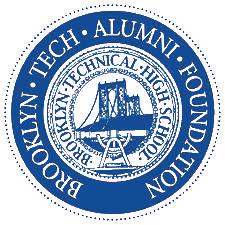
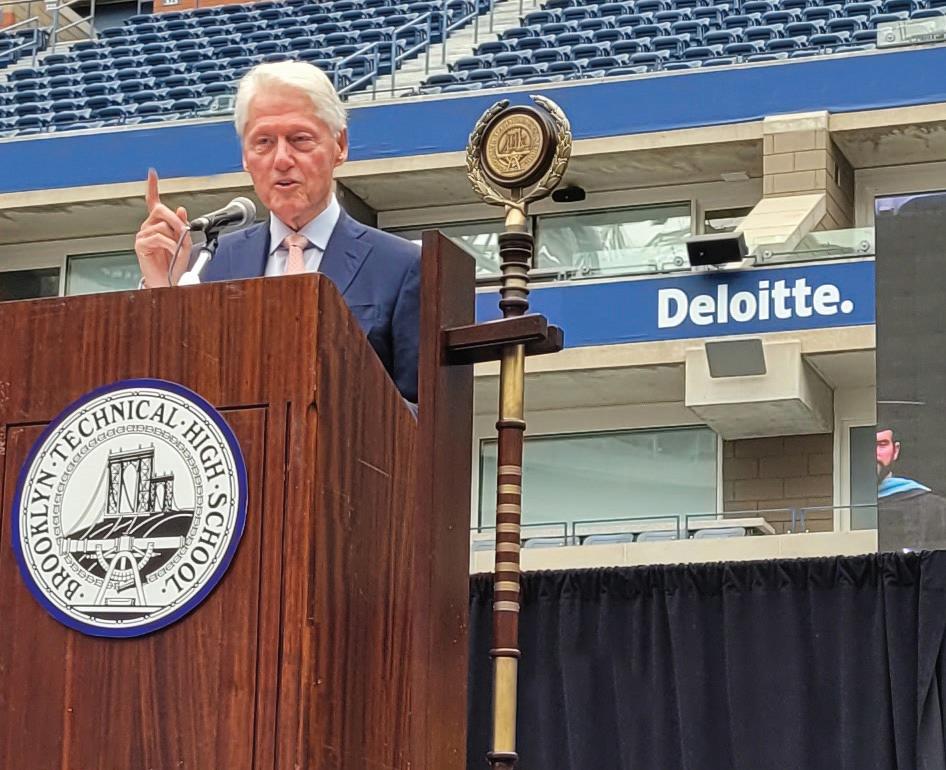
“Thanks to the openness of Brooklyn Tech and its commitment to excellence and empowerment, the graduates of this school have changed our world for the better. They have expanded the STEM horizons — in science, technology, engineering and math.”
President Bill Clinton, Commencement keynote speaker, Arthur Ashe Stadium, June 24, 2022